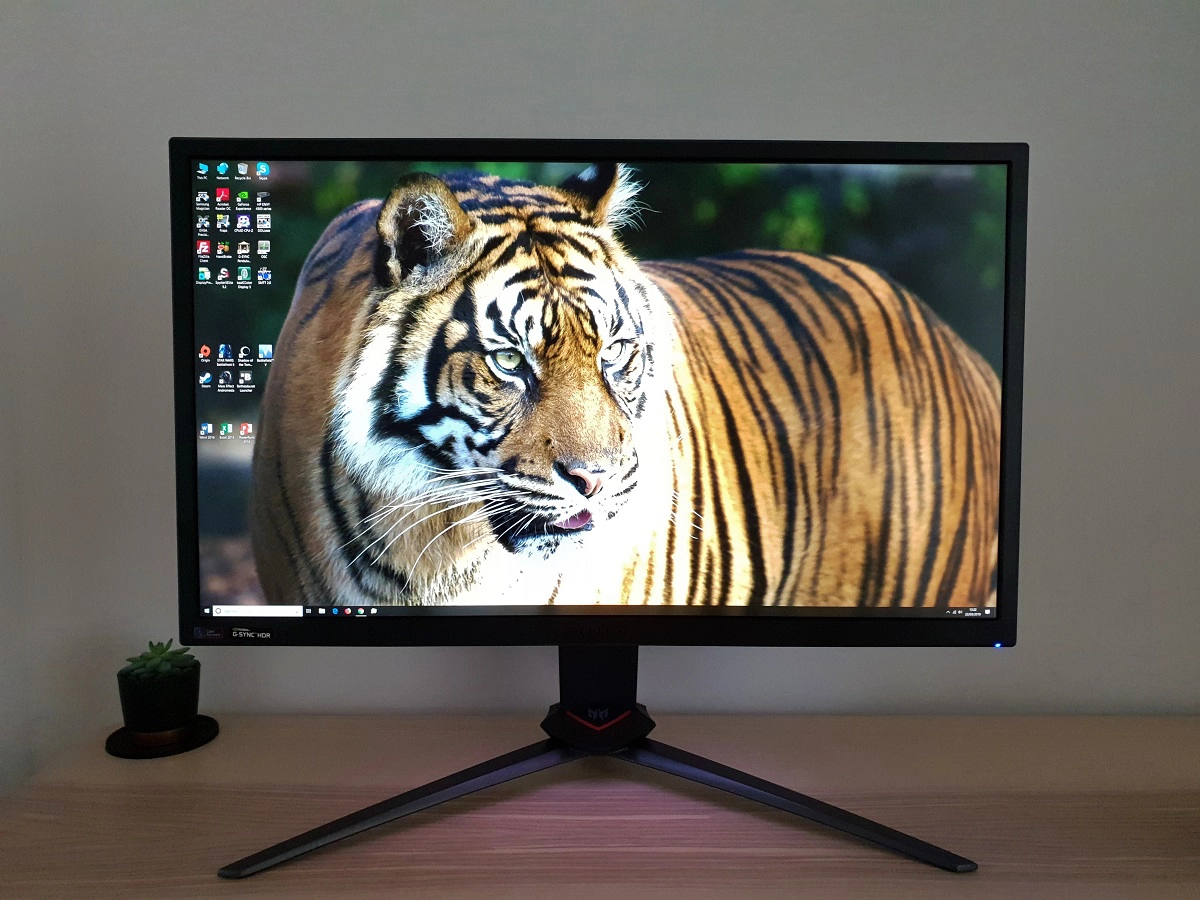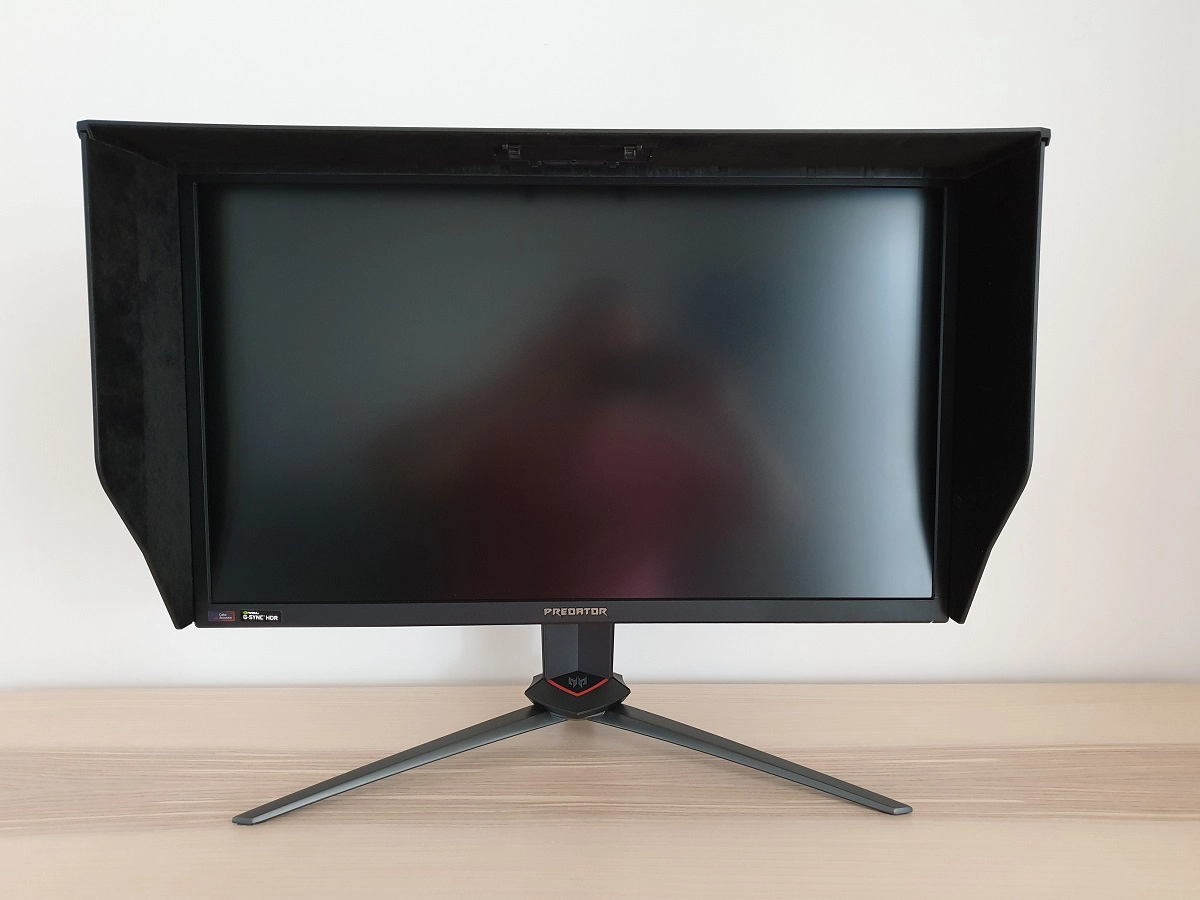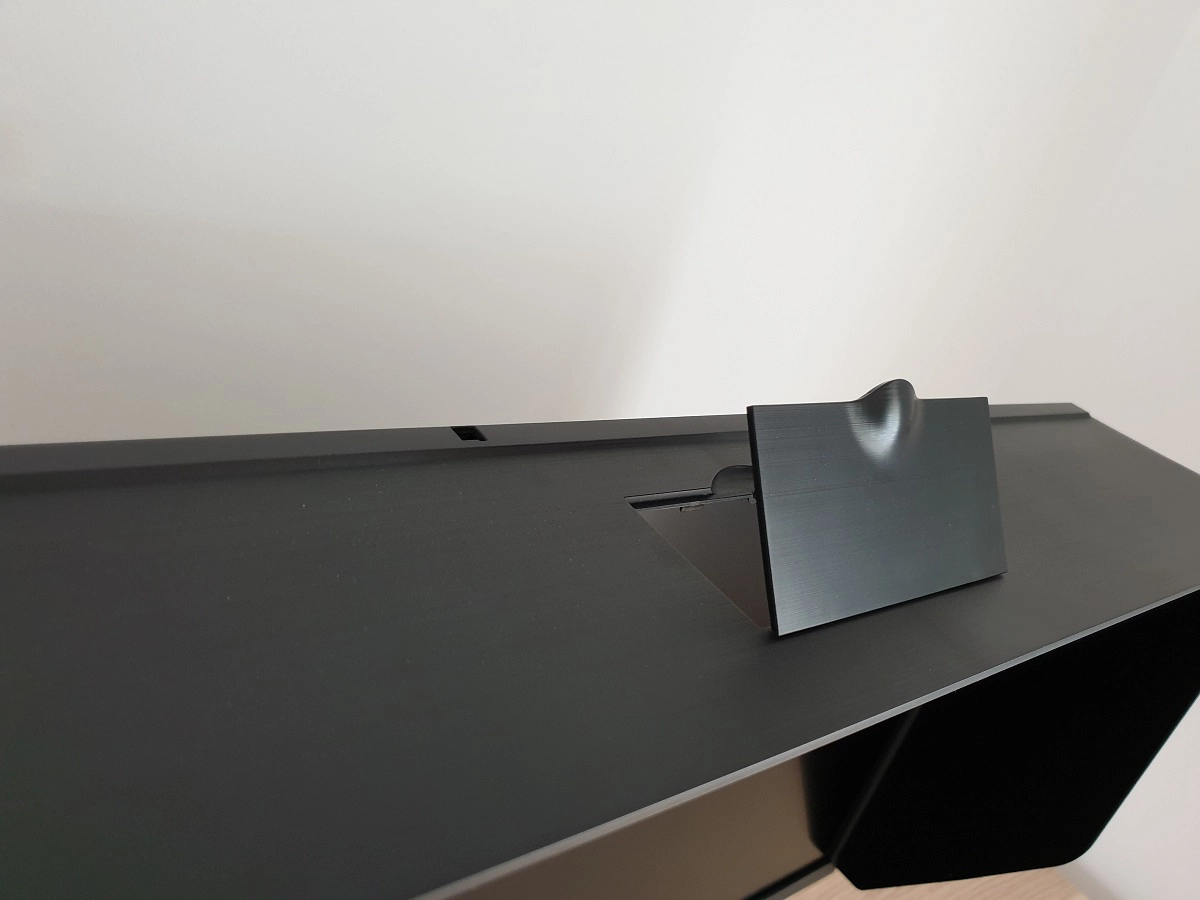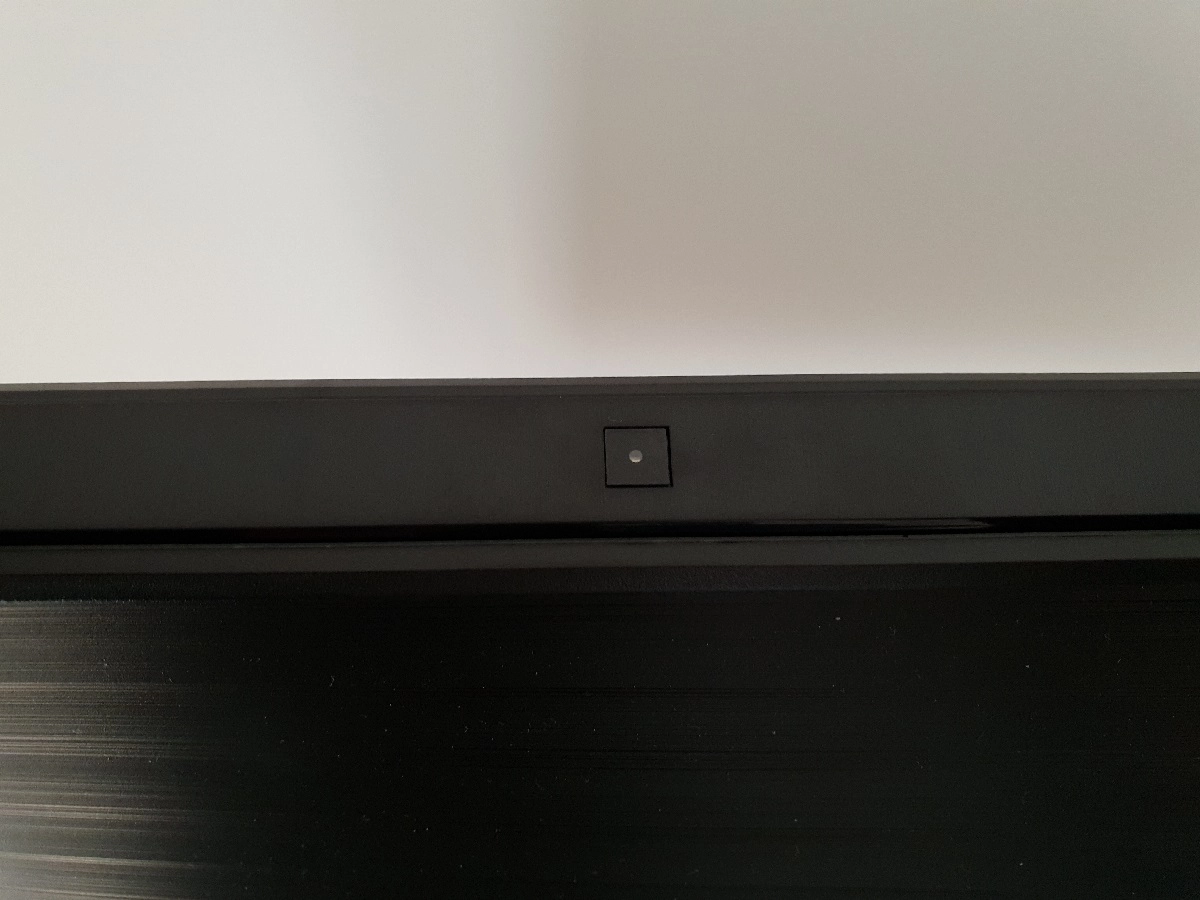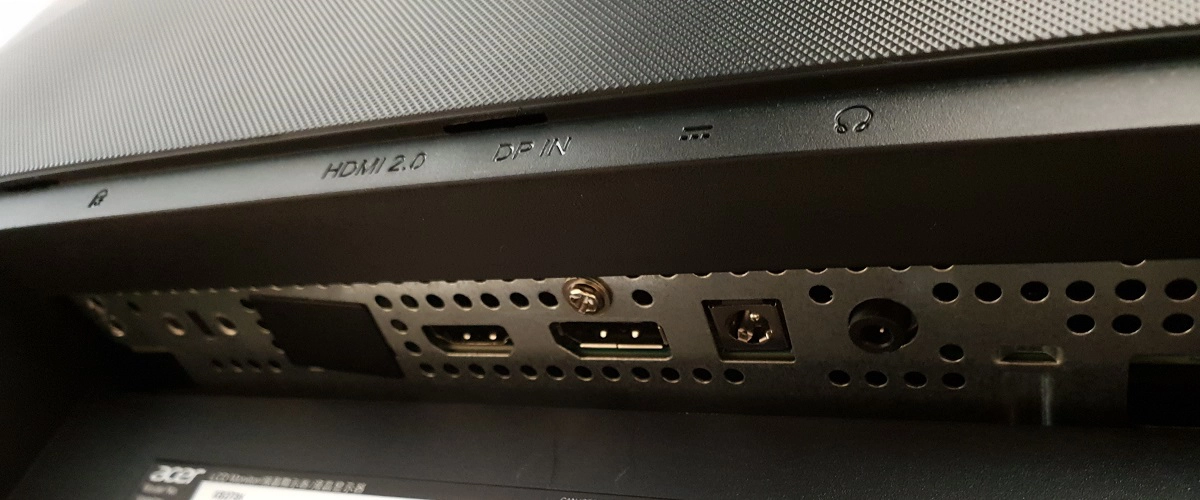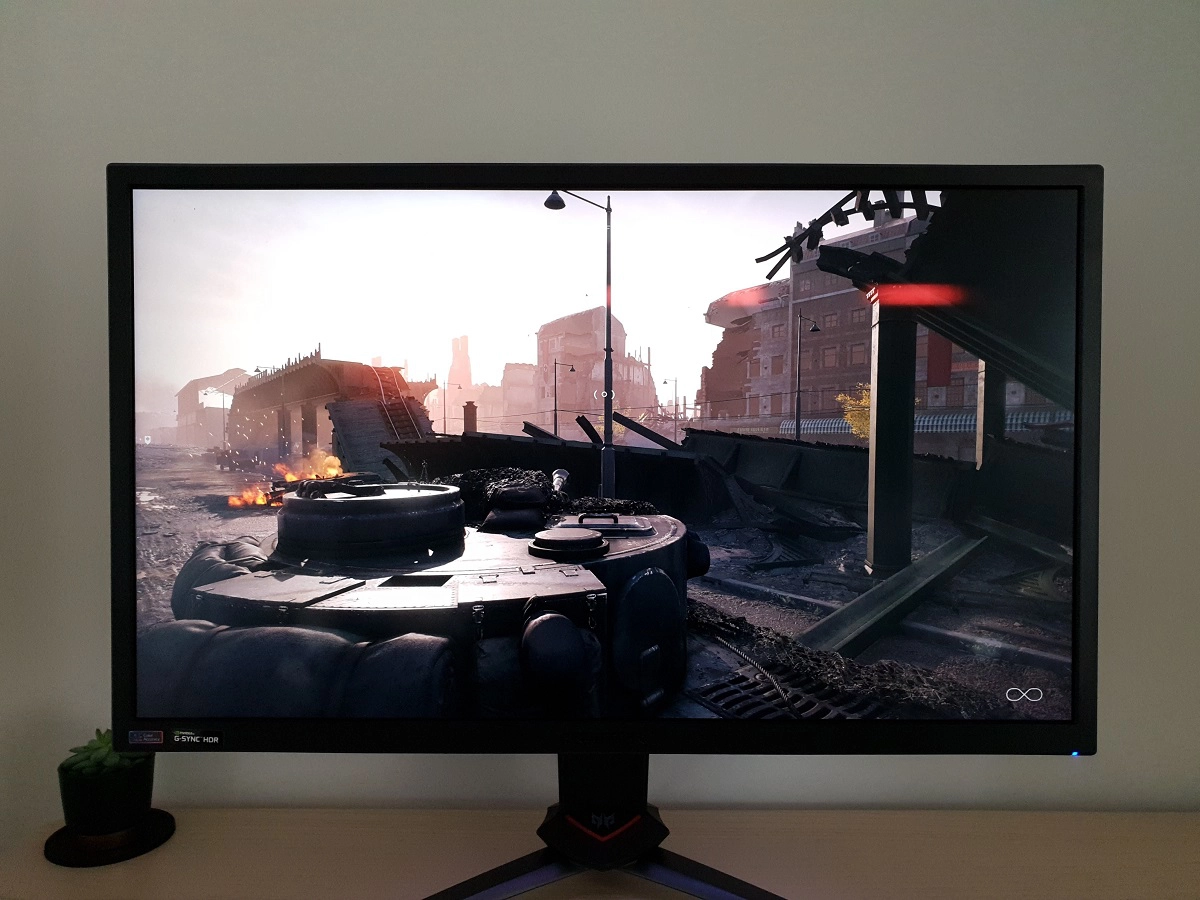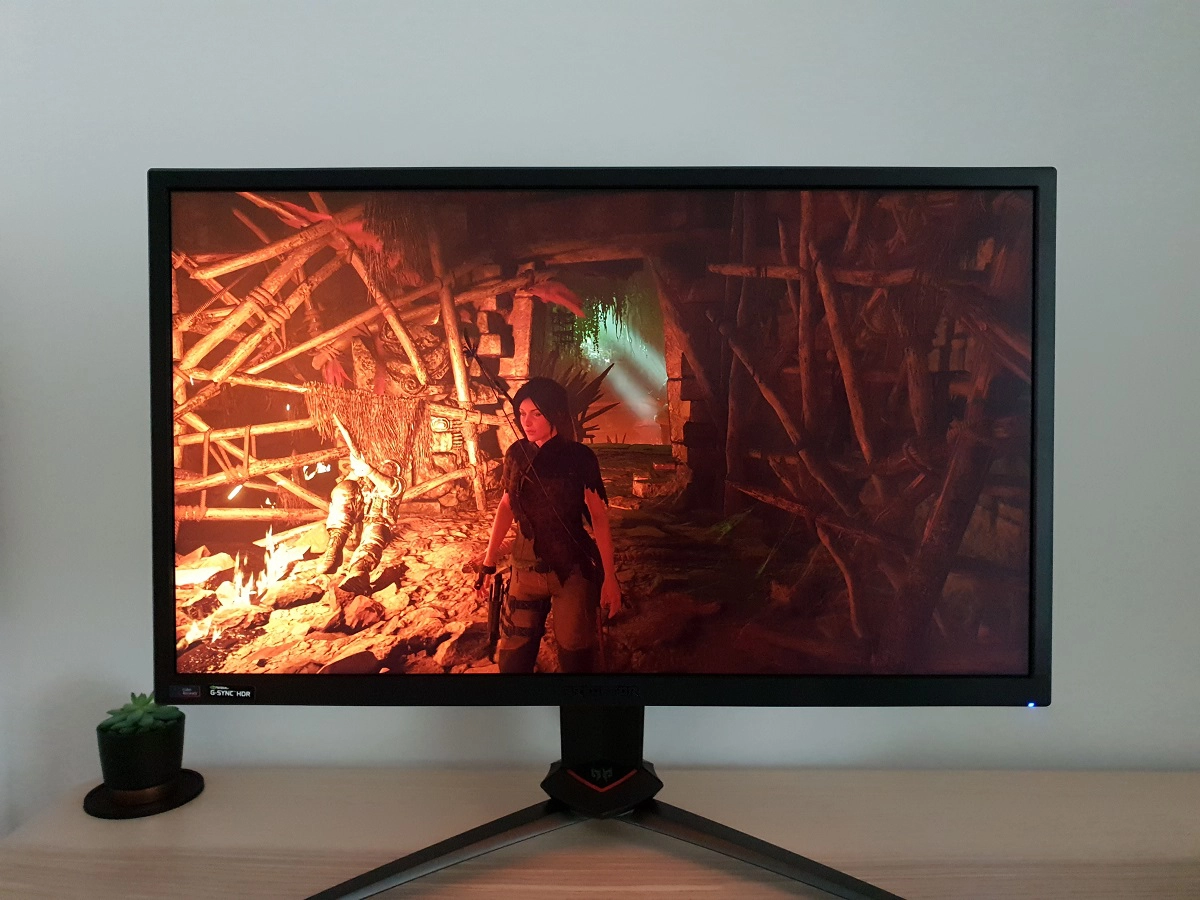Author: Adam Simmons
Date published: March 29th 2019
Table of Contents
Introduction
For users wanting a combination of high refresh rate and high resolution, there are very few options out there. There are a few models which combine the 3840 x 2160 (‘4K’ UHD) resolution with a 144Hz refresh rate and a host of other high-end features such as VESA DisplayHDR 1000 support and a complex backlighting array. These all-encompassing models, which include the PG27UQ, come at a huge premium. The Acer XB273K (also referred to as the XB273K P or XB273K Pbmiphzx) of the company’s Predator gaming monitor lineup offers a slightly cut down and less costly alternative. It does away with the powerful FALD (Full Array Local Dimming) backlight and VESA DisplayHDR 1000 capability – but retains the resolution, refresh rate, G-SYNC and a simpler backlighting solution with VESA DisplayHDR 400 support. We put this intriguing product through its paces in our usual array of ‘real world’ tests.
Specifications
The monitor employs an AHVA (IPS-type) panel, with a 3840 x 2160 (‘4K’ UHD) resolution and a 144Hz refresh rate. 10-bit colour is supported and a 4ms grey to grey response time is specified. A Quantum Dot LED backlight is used to enhance the colour gamut. As usual, treat specified response times with a degree of scepticism. Some of the key ‘talking points’ of the specification have been highlighted in blue below.
The monitor follows some of the design cues that are usual for models in the series, with plenty of straight edges and a shapely tripod-shaped stand. It is somewhat less ‘in your face’ with its aesthetic features than some older models in the series, however. The stand is powder coated metal, with a central red band surrounding a silver emblem. The bezels are certainly not as sleek as on some models, but the backlight design used here doesn’t lend itself well to ultra slim bezels. And neither does attachment of the included anti-glare hood, which allows the user to attach a shield to the top and sides to help reduce the amount of light striking the screen surface and hence reduce glare. We didn’t have any particular issues without this addition, but some users may find it useful depending on their lighting environment. The bezels are ~14mm (0.55 inches) and matte black at the top and sides (hood detached). At the bottom, the bezels are ~22mm (0.87 inches) and matte black plastic with a subtle woven texture. The centre of the bottom bezel has a shiny silver ‘Predator’ logo. The screen has a very light matte anti-glare finish, as explored later. The OSD (On Screen Display) is controlled by a combination of pressable buttons and a joystick at the rear of the monitor, running vertically down the right side (as viewed from the front). The video below runs through the functionality of the menu system. It also takes a look at the ‘Ambient Light’ LED lighting feature of the monitor, which includes a strip of 12 customisable RGB LEDs underneath the monitor and additional customisable LEDs behind the monitor. From the side the monitor is reasonably bulky – ~23mm (0.91 inches) at the thinnest point, lumping out more centrally. At the left side there are 2 USB 3.0 ports (top one supports fast-charging). The robust stand with good ergonomic flexibility is visible from this angle. It offers; tilt (-5° to 25°), height (3.94” or 100mm) and swivel adjustment (20° left and 20° right). At lowest screen height the bottom of the screen clears the desk by ~75mm (2.95 inches), with the top of the screen ~450mm (17.72 inches) above the desk surface. The total depth of the monitor including stand is ~310mm (12.20 inches) with the screen quite close to the front. So the design is reasonably deep, although not compared to some models, particularly gaming monitors. There is an ambient light sensor at the top of the monitor, facing upwards. The rear of the monitor continues the angular appearance. It combines textured satin-effect elements near the top with matte black plastic further down. A headphone hook can be found near the top of the stand, at the rear, which is extended by pressing in at the bottom. There is an upwards-pointing chevron of ventilation slats at the boundary between the two plastic textures. This houses some of the ‘Ambient Light’ LEDs as explored in the OSD video and also 2 x 4W speakers. These provide decent sound output with plenty of volume and less of a ‘tinny’ quality than many integrated speakers solutions. Although not the cleanest or bass-rich sound output you’ll come across. The included stand attaches centrally and can be removed by taking off the plastic surrounding it. You can then replace it with an alternate 100 x 100mm VESA compatible solution. Towards the bottom left there are the OSD controls, with red markings used for the controls. Towards the right there are 2 USB 3.0 downstream ports (plus upstream). The remaining ports are down-firing, located centrally, and include; HDMI 2.0b, DP 1.4, DC power input (external ‘power brick’ and a 3.5mm headphone jack). There is also a K-Slot, just to the right of the HDMI port. DisplayPort 1.4 must be used on a compatible Nvidia GPU to harness the full capabilities of the monitor, including 3840 x 2160 @ 144Hz and G-SYNC. HDMI 2.0 supports 3840 x 2160 @ 60Hz and like DP 1.4 offers HDR support – this will come as welcome news to HDR games console owners who rely on HDMI 2.0 for their experience. A power adaptor and cable, DP cable and USB 3.0 cable are included as standard accessories. The monitor offers active cooling and has a fan, with ventilation around the stand attachment point and above it (the chevron of ventilation slats mentioned earlier). We found this fan to be very quiet, it was never heard by anybody using the computer or others in the room above the system fans even with the system idling. Or indeed with the monitor set to a high brightness, including running HDR. Some users have a silent system so they may find the addition of fans in a monitor annoying, but others really shouldn’t worry about them. Also note that they have a spool-down time after the monitor switches off, so will remain running for a little bit whilst the monitor cools down. The image below is a macro photograph taken on Notepad with ClearType disabled. The letters ‘PCM’ are typed out to help highlight any potential text rendering issues related to unusual subpixel structure, whilst the white space more clearly shows the actual subpixel layout alongside a rough indication of screen surface. A very light matte (some users may call it ‘semi glossy’) anti-glare screen surface is employed, offering decent glare-handling whilst preserving clarity and vibrancy better than many matte screen surfaces. The surface texture is reasonably smooth, giving only a very light misty graininess. The screen surface seems slightly smoother and lighter (lower haze) than on the more expensive cousins of this model. RTINGS.com has a good article which summarises chroma subsampling and its implications. The article reinforces our own testing, which strongly suggests that this is a non-issue for games and movies. These are designed to look appropriate even if chroma subsampling (reduced chroma, 4:2:2) is used. Such content needs to look good on a wide range of TVs, where chroma subsampling is much more common. There may be rare exceptions if particularly thin text is shown, so you may see a fringe as you can see on the desktop. But we didn’t come across any specific examples of this. Users should therefore feel free to use 144Hz when gaming, but a 120Hz maximum is recommended when you’re on the desktop. In that environment, the effects of the 4:2:2 signal are very noticeable indeed. This monitor includes various presets, referred to simply as ‘Modes’; ‘Action (G1)’, ‘Racing (G2), ‘Sports (G3), ‘User’, ‘Standard’, ‘ECO’, ‘Graphics’ and ‘Movie’. These presets simply change various settings in the OSD. If you make manual adjustments to most settings (including but not limited to brightness, contrast or the colour channels) the monitor will switch to the ‘User’ setting which is fully customisable. The first 3 presets (G1, G2 and G3 for short) are fully customisable and allow you to easily save and recall different sets of monitor settings. Some settings you adjust here are applied universally, though, so can’t be set independently for each different ‘G’ preset. You can’t save things such as individual colour channel adjustments, different ‘SDR Variable Backlight’ or ‘SDR Colors sRGB’ statuses. But you can certainly save and recall different brightness levels, contrast levels and ‘Low Blue Light’ levels. Given the behaviour of the presets, we will be focusing on various manual adjustments in the OSD for this table. The table below gives gamma readings taken using a DataColor Spyder5ELITE and white point measurements taken using a BasICColor SQUID 3 (X-Rite i1Display Pro), alongside general observations. Our test system runs Windows 10 with an Nvidia GTX 1080 Ti connected using the supplied DisplayPort cable. No additional monitor drivers or ICC profiles were specifically loaded. The monitor was left to run for over 2 hours before readings were taken or observations made. Aside from our ‘Test Settings’ where various adjustments are made, assume factory defaults are used. The exception to this was that the ‘SDR Variable Backlight’ was set to ‘Off’. Unless otherwise stated assume the refresh rate was set to 120Hz in Windows, as this was our preferred setting for the desktop. Although this didn’t significantly affect the values or observations in this table compared to lower values. When viewing the figures in this table, note that for most PC users ‘6500K’ for white point and ‘2.2’ for gamma are good targets to aim for.
As an Amazon Associate I earn from qualifying purchases made using the below link. Where possible, you’ll be redirected to your nearest store. Further information on supporting our work.

Features and aesthetics
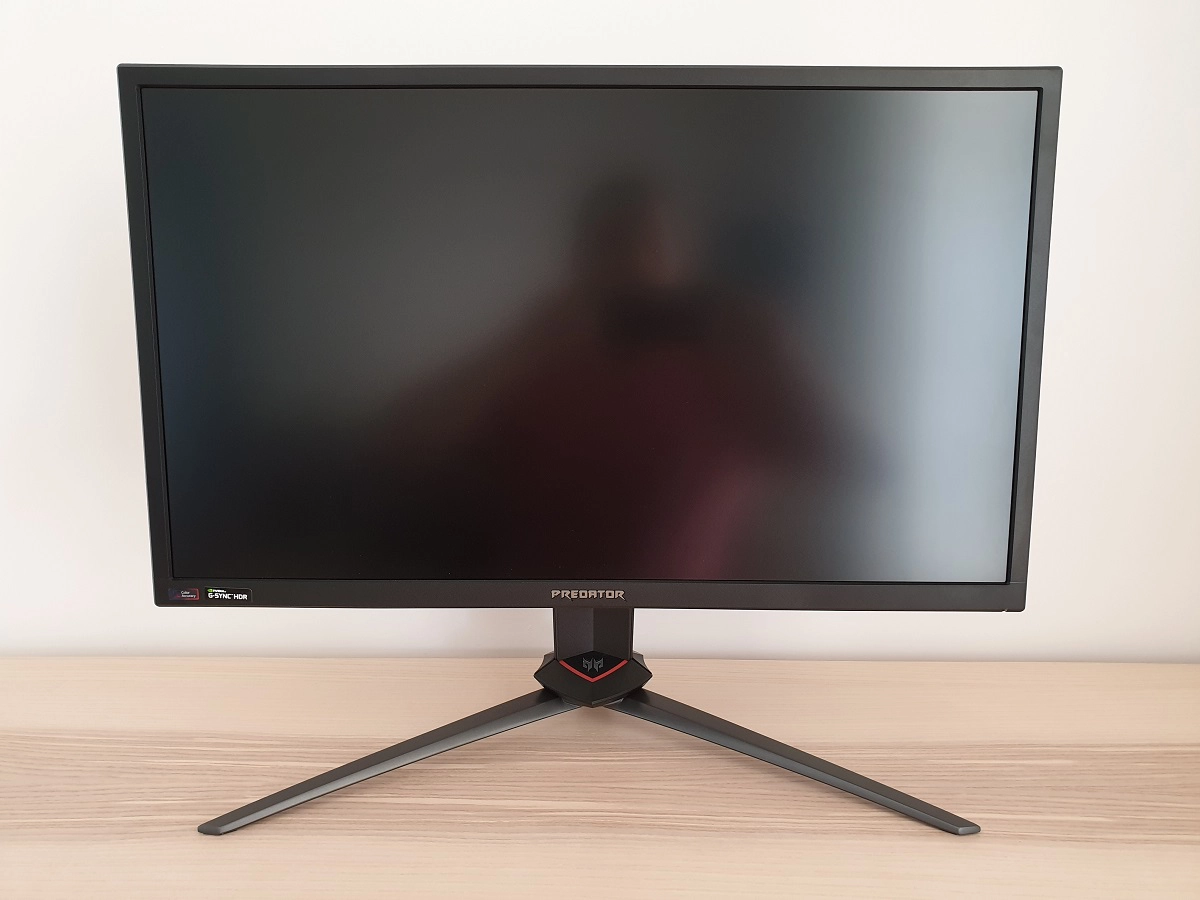
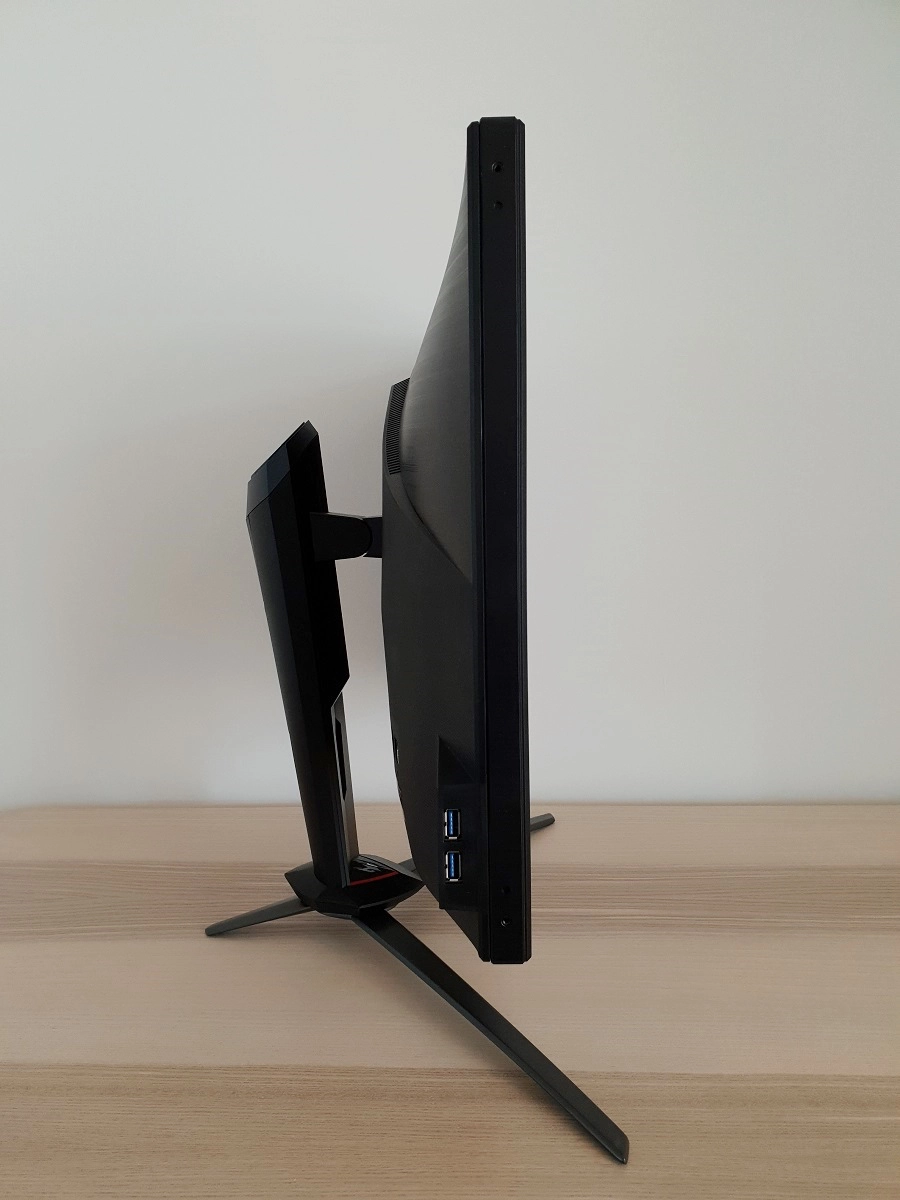
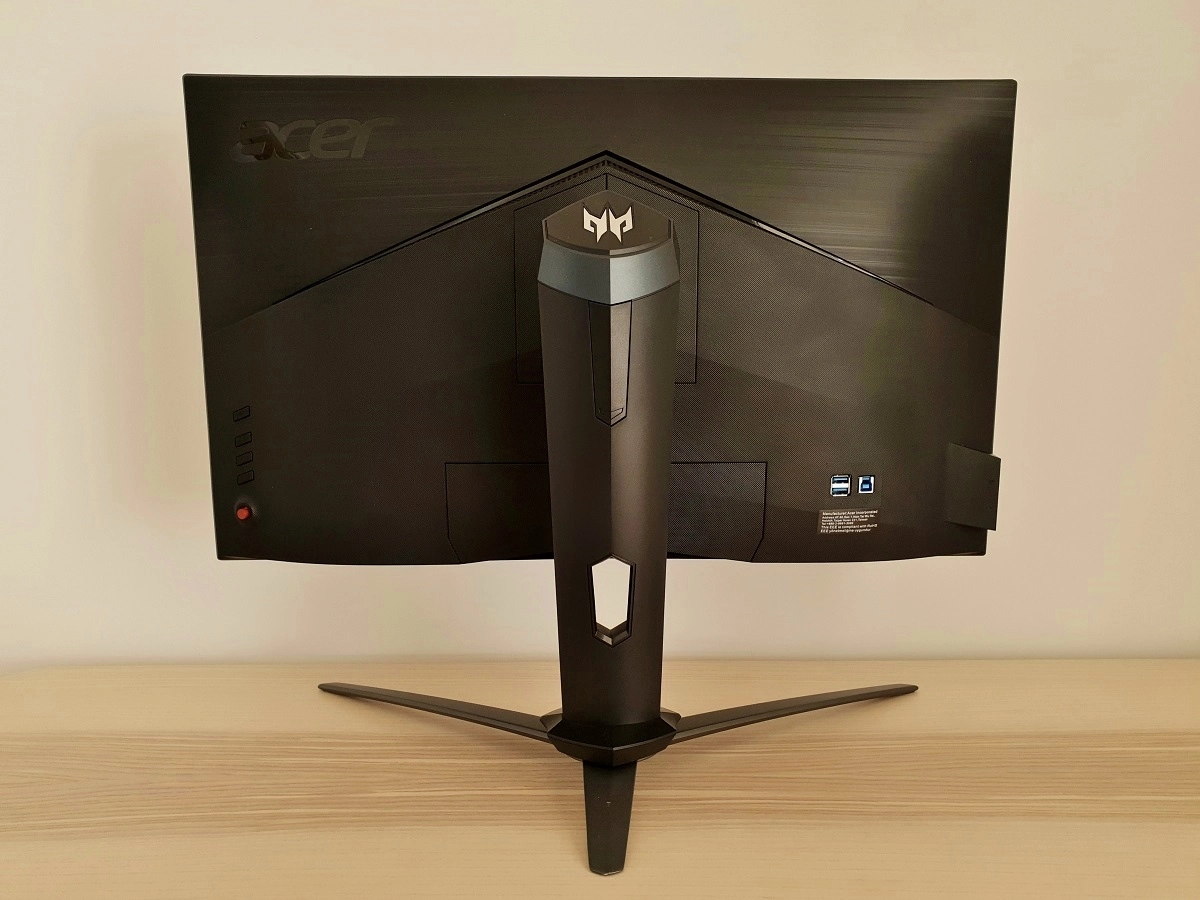
Calibration
Subpixel layout and screen surface
![]()
As shown above, the monitor uses the standard RGB (Red, Green and Blue) stripe subpixel layout. This is the default expected by modern operating systems such as Microsoft Windows and Apple MacOS. You needn’t worry about text fringing from non-standard subpixel layouts as a Mac user, whilst Windows users don’t need to run through the ClearType wizard. They may wish to run through that and adjust according to preferences, however. The subpixel layout and arrangement is normal and we had no subpixel-related concerns related to sharpness or text clarity on this model. The screen surface and pixel density invited strong text clarity, in fact. The exception to this was with the monitor running 3840 x 2140 @ 144Hz. This forces the use of a compressed colour signal called ‘YCbCr422 (4:2:2)’ rather than ‘Full Range RGB” (4:4:4)’. This compression is required to save bandwidth and enable the monitor to output at this resolution and refresh rate. The signal type employs what is referred to as chroma subsampling (4:2:2), which gives a rainbow-like fringe to some text. This is most noticeable with slender text on plain backgrounds. You can see this fringing clearly in the ‘Display’ – ‘Change resolution’ section of Nvidia Control Panel, for example. Notice the cyan fringe around the ‘Customise…’ button and the fringe around various text elements. Compare the top image (120Hz, Full Range RGB / 4:4:4 Full Chroma) with the bottom image (144Hz, YCbCr422 4:2:2 Reduced Chroma). The image was actually taken on the ASUS PG27UQ, but it’s showing exactly the same thing we’re describing here.
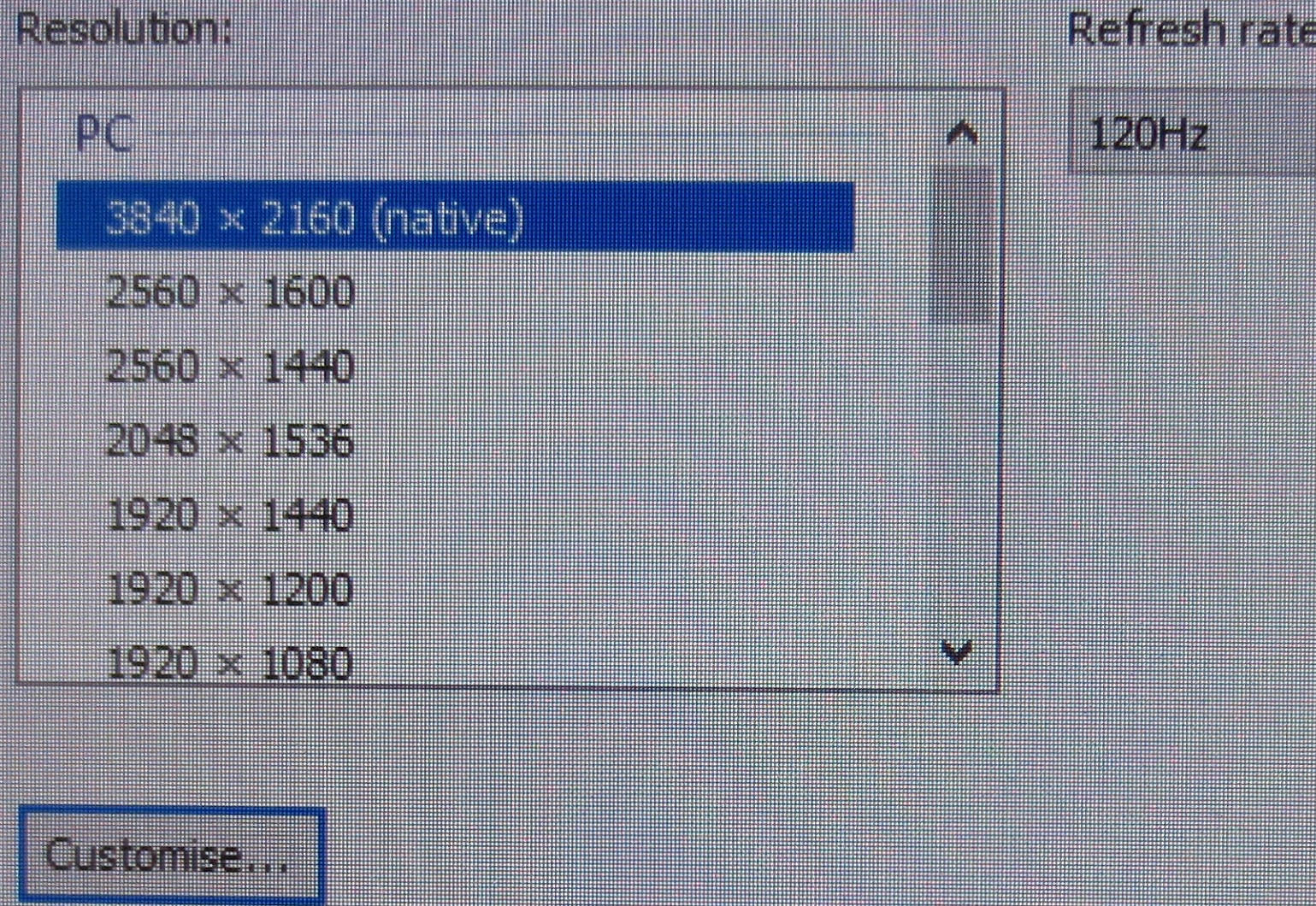
Testing the presets
Preset Mode Gamma (central average) White point (kelvins) Notes Standard Mode (Factory Defaults) @120Hz 2.2 6586K The image appears bright, with an unmistakably vibrant but varied look. Strong saturation levels are maintained throughout the screen and overall balance is good with respect to white point and gamma. Standard Mode (Factory Defaults) @144Hz 2.2 6590K Similar to above, aside from the issues highlighted previously regarding the use of chroma subsampling. SDR Colors sRGB = On 2.2 6591K This is an ‘sRGB emulation’ mode which restricts colour gamut of the monitor significantly so that it follows sRGB very closely. Saturation levels are reduced significantly and the image appears less ‘vibrant’ as a result. Overall balance to the image is very good. Relative Gamma = -0.6 1.6 6570K As factory defaults but gamma significantly lower. The image appears completely washed out. The measured gamma matches the claimed offset value. Relative Gamma = -0.3 1.9 6570K As above but a bit more depth. Still an obvious lack of depth and saturation overall. The measured gamma again matches the claimed offset. Relative Gamma = +0.3 2.5 6590K As above but the gamma is now higher than default. This gives some extra depth and saturation. The measured gamma matches the claimed offset. Relative Gamma = +0.6 2.8 6594K As above, but gamma raised further. The image appears very too and rather striking – a very cinematic look, but clear loss of detail for dark shades. And you guessed it, the measured gamma again matches the claimed offset. Blue Light = 80% 2.2 5617K A relatively weak (but still fairly effective) Low Blue Light (LBL) setting. The blue colour channel and blue light output from the monitor is reduced significantly, the image appears noticeably warmer. Blue Light = 70% 2.2 5314K As above but slightly more effective. The image appears a bit warmer still and has a mild green tint. Blue Light = 60% 2.2 5104K As above, but image is warmer and green tint slightly stronger. Blue Light = 50% 2.2 4967K A very effective LBL setting. The image is significantly warmer than default and there is a noticeable green tint. The green channel is not lowered, but the blue channel is (significantly). Test Settings (as below) 2.2 6495K Similar to factory defaults, but white point slightly rebalanced and brightness set to a more comfortable level. The image appears vibrant and varied.
The monitor provided a vibrant and varied image, with good balance to the gamma and white point out of the box. An effective sRGB emulation setting is also included, which is an appropriate setting for colour-critical work within the sRGB space. It’s also a toggle rather than an isolated preset, so it doesn’t restrict other changes in the OSD. Following the adjustments made to our ‘Test Settings’ the gamma tracking remained strong. The graph below shows the excellent adherence of the monitor’s gamma to the ‘2.2’ curve. The gamma behaviour was very similar using the factory defaults and was not significantly altered when using 144Hz complete with its compressed (reduced chroma) colour signal. The monitor also offers a ‘Blue Light’ LBL setting, with varying effectiveness from ‘50%’ (highest reduction) to ‘80%’ (weakest reduction). The strongest setting in particular was highly effective. At successively stronger settings, the brightness is reduced – but for maximum reduction at any setting we’d advise lowering brightness further, as long as that’s comfortable for you. We used this for our own viewing comfort in the evening (at reduced brightness), although not for any specific testing beyond that involving this setting. It’s important to cut blue light exposure as much as possible in the hours leading up to sleep as blue light is stimulating and disrupts sleep hormones. Some users find such settings more relaxing on the eyes at other times of the day, too. With the more effective LBL settings in particular, there is an increasing green tint. You adapt to this to an extent, so it becomes less noticeable given a little time. Maintaining a strong green channel maximises contrast when LBL settings are applied, so it isn’t particularly uncommon to see this. Our ‘Test Settings’ didn’t involve any dramatic changes. Lowering brightness and slightly adjusting colour channels, but brightness aside the ‘out of the box’ balance to the image was actually very good. Assume any setting not mentioned, including ‘Contrast’, was left at default for the ‘Standard’ setting. The exception to this was the ‘SDR Variable Backlight’, which was disabled for consistency in the review. This is explored separately in various sections of the review. Be aware that individual units and preferences vary, so these settings aren’t going to be optimal in all cases and are just a suggestion. We’ve also included the ‘Over Drive’ setting, just for reference. Aside from the HDR section, all of our testing was performed with applications and the monitor running in their normal SDR (Standard Dynamic Range) state. HDR has its own OSD settings associated with it. Note that the ‘Peak white (nits)’ setting becomes ‘Ref. white (nits)’ but is greyed out under HDR and can’t be adjusted. This is a hangover from the Acer X27, which uses a similar OSD and did allow this setting to be altered. We left everything as per our ‘Test Settings’ under HDR, meaning everything was as default except for the colour channel adjustments. Peak white (nits) = 170 (according to preferences and lighting) SDR Variable Backlight = OFF (unless otherwise stated) Color Temp. = User Red Color= 50 Green Color= 49 Blue Color= 46 Over Clock= On Over Drive= Normal Refresh rate num = Off Refresh rate (Windows setting)= 120Hz (desktop and HDR) / 144Hz (SDR gaming) We used a BasICColor SQUID 3 (X-Rite i1Display Pro) to measure white and black luminance levels, from which static contrast ratios could be calculated. The table below shows this data with a range of settings used, including those covered in the calibration section. Assume any setting not mentioned was left at default, except for the changes already covered in the calibration section. Black highlights indicate the highest white luminance, lowest black luminance and maximum contrast ratio recorded under SDR (‘SDR Variable Backlight’ disabled). Blue highlights show the results with HDR active and also under our ‘Test Settings’.
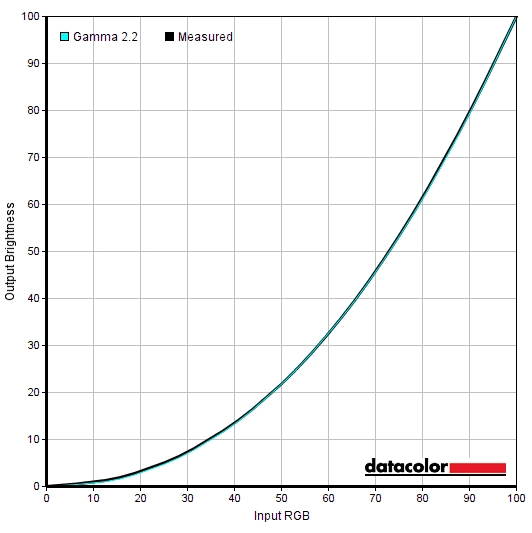
Gamma 'Test Settings'
Test Settings
Mode= ‘Standard’ (becomes ‘User’ after modified)
Contrast and brightness
Contrast ratios
Monitor Settings White luminance (cd/m²) Black luminance (cd/m²) Contrast ratio (x:1) Peak white (nits) = 450 461 0.42 1098 Peak white (nits) = 400 409 0.37 1105 Peak white (nits) = 350 356 0.32 1113 Peak white (nits) = 300 304 0.28 1086 Peak white (nits) = 250 252 0.23 1096 Peak white (nits) = 200 199 0.18 1106 Peak white (nits) = 150 148 0.13 1138 Peak white (nits) = 100 97 0.09 1078 Peak white (nits) = 50 47 0.04 1175 Peak white (nits) = 360 (Factory Defaults) 368 0.33 1115 Refresh rate = 144Hz 368 0.33 1115 HDR* 468 0.34 1376 SDR Variable Backlight = On** 381 0.28 1361 SDR Colors sRGB = On 367 0.33 1112 Relative Gamma = -0.6 368 0.33 1115 Relative Gamma = -0.3 368 0.33 1115 Relative Gamma = +0.3 368 0.33 1115 Relative Gamma = +0.6 368 0.33 1115 Blue Light = 80% 363 0.33 1100 Blue Light = 70% 336 0.31 1084 Blue Light = 60% 289 0.27 1070 Blue Light = 50% 266 0.25 1064 Test Settings 168 0.15 1120
*HDR measurements were made using this YouTube HDR brightness test video, running full screen at ‘2160p 4K HDR’ on Google Chrome. The maximum reading from the smallest patch size (measurement area) that comfortably covered the entire sensor area and colorimeter housing was used for the white luminance measurement, which was ‘4% of all pixels’ in this case. The black luminance was taken at the same point of the video with the colorimeter offset to the side of the white test patch, equidistant between the test patch and inner edge of the monitor bezel.
**Measurements for the ‘SDR Variable Backlight’ setting were made in the same way, but with the monitor and test running in SDR.
The average contrast ratio with only brightness adjusted was 1110:1, which is in-line with expectations for the panel type. Following the adjustments made to our ‘Test Settings’, we measured 1120:1 which is quite pleasing. The monitor maintained >1000:1 under all settings tested on this table, including the sRGB emulation mode and LBL settings. The ‘Peak white (nits)’ value corresponded closely with the measured luminance values, so it’s nice that Acer arranged things in that way as it can help users refine their preferred settings and compare with other models that have been measured in reviews and by users. The maximum white luminance we recorded on this table under SDR was a pretty bright 461 cd/m², whilst the minimum white luminance recorded was a reasonably dim 47 cd/m². This gives a brightness adjustment range of 414 cd/m², with a decent minimum and fairly bright maximum – plus values which, again, correspond closely to the OSD figures.
Under HDR the monitor is able to make use of its local dimming capability. This gave a slight bump in contrast to 1376:1. The local dimming capability can be used under SDR by using the ‘SDR Variable Backlight’ setting. This yielded a contrast of 1361:1. This slight boost in contrast is certainly nice to have, as it doesn’t really come with any obvious drawback. So many users will happily keep this setting enabled. But the boost in contrast is really only quite slight and also quite situational. That’s because the local dimming solution is fairly basic, we estimate that the monitor uses only 3 dimming zones. This avoids the localised ‘halo’ effect you can see on solutions which use a larger but not extreme number of dimming zones (such as the 384-zone FALD solutions employed on the PG27UQ and X27). Note that the ‘Peak white (nits)’ setting didn’t significant affect the contrast readings under this methodology and there was no substantial benefit to choosing a different black measurement site. Also note that this is far more representative of the ‘real-world’ effectiveness of a local dimming solution than methodologies which use pure black and pure white field measurements (i.e. screen fills). Those methodologies are essentially giving a dynamic contrast measurement which is never replicated in normal usage and will give artificially elevated contrast readings.
PWM (Pulse Width Modulation)
The XB273K does not use PWM (Pulse Width Modulation) to regulate backlight brightness at any level and instead uses DC (Direct Current). The backlight is therefore considered ‘flicker-free’, which will come as welcome news to those worried about side-effects from PWM usage.
Luminance uniformity
Observing a black screen in a dark room under our ‘Test Settings’ revealed a small amount of backlight bleed and clouding. This is shown in the image below, taken a sufficient distance back to eliminate any ‘AHVA glow’ (‘IPS glow’). This is a silverish or golden glow (depending on viewing angle) that is visible most noticeably towards the bottom corners of the screen from a normal viewing position. It is not as extreme as we’ve seen on some IPS-type models of this size, although this isn’t exactly what we’d consider a ‘low glow’ panel. The glow also ‘blooms out’ as viewing angle is sharpened, as shown in a video later on in the review. Note that individual units vary when it comes to all aspects of uniformity, including backlight bleed. The luminance uniformity was reasonable overall. The maximum luminance was recorded at ‘quadrant 5’ in the centre screen (162.3 cd/m²). The greatest deviation from this occurred at ‘quadrant 7’ towards the bottom left (135.9 cd/m², which is 16% dimmer). The average deviation between each quadrant and the brightest recorded point was 9.13% which is fairly respectable. Note that individual units vary when it comes to uniformity and you can expect further deviation beyond the points measured. For example, at the extreme edges (right next to the bezel) things appeared noticeably cooler. This was just a small section of the screen and we didn’t find it bothersome, but it’s worth noting as it isn’t assessed in the zones measured. The contour map below gives a graphical representation of these deviations, with darker greys representing lower luminance (greater deviation from brightest point) than lighter greys. The percentage deviation between each quadrant and the brightest point recorded is also given. Deviations in colour temperature (white point) were also assessed, using the same 9 quadrants. Deviations here are assigned DeltaE values, with higher values representing greater deviation from the D65 (6500K) daylight white point target than lower values. The contour map below shows this, with stronger shades indicating greater deviation from the 6500K target. A DeltaE of >3 here is considered significant deviation that most users could notice quite readily by eye. The results here were excellent. There were no significant deviations, with a maximum deviation of just DeltaE 1.3 towards the right of centre. As with other aspects of uniformity, individual units vary and you can expect further deviation beyond the measured points. Note that the observations below were made using our ‘Test Settings’ with ‘SDR Variable Backlight’ off. This feature is analysed separately in a later section of the review. On Battlefield V the monitor provided a decent contrast performance, overall. The level of detail in dark areas was much as it should be for the central mass of the screen. There were some losses peripherally due to ‘AHVA glow’, particularly near the bottom corners of the screen. Whilst this was subdued slightly compared to some IPS-type models of this size, it was still a feature and did eat away at some of the detail and affect the atmosphere for these dark scenes. Brighter elements stood out nicely and appeared reasonably smooth thanks to the very light matte screen surface and lack of obvious graininess to the surface texture. There was a light misty graininess, nothing most users will find at all bothersome. We made similar observations on Shadow of the Tomb Raider. This title is brimming with dark caves, tombs and passageways so demands a strong contrast performance. The XB273K again provided a decent experience here, but nothing to write home about. There was some loss of detail in dark areas and a loss of ‘atmosphere’ peripherally, due to ‘IPS glow’. Although things were better centrally and bright elements such as candles and torches stood out nicely against darker surroundings. The screen surface again kept the brighter shades appearing reasonably smooth, with only a very light misty graininess. Finally, we made some contrast assessments using the film Star Wars: The Last Jedi. This is a film with plenty of contrasting elements. Lightsaber battles in gloomy interior locations, space ships firing large bolts of energy through dark space and the ensuing explosions – that sort of thing. The monitor didn’t provide the cinematic look or depth to dark shades of one with a much stronger contrast, although the film was still enjoyable to watch with decent distinction between the bright and dark shades. Especially if you’re not one to sit in a dark room and watch films, which can cause disappointment with pretty much any LCD panel. The bright elements didn’t appear overly grainy, either, and had decent ‘pop’ to them thanks to the screen surface. The Lagom tests for contrast allow specific weaknesses in contrast performance to be identified. The following observations were made with eyes around 70cm from the screen. The Acer XB273K’s colour gamut (red triangle) was compared to the sRGB (green triangle) and Adobe RGB (purple triangle) reference spaces, as shown in the first image below. The monitor offers full coverage of sRGB (100%) with good extension beyond this as well (86% Adobe RGB). This model doesn’t target Adobe RGB coverage, specifically, but Acer specifies 90% DCI-P3 coverage instead. This is the near-term target for HDR so it’s appropriate in this case. Our colorimeter software doesn’t allow comparison with the DCI-P3 space, unfortunately, but what we see in the diagram below reflects at least this coverage level. It appears to extend somewhat beyond this in fact. It’s enough to allow the monitor to display all shades within the sRGB colour space, with an extra dose of vibrancy for SDR content. And allows good use of the HDR10 pipeline’s preferred colour space for content which supports this. The second image below shows the ASUS PG27UQ’s native colour gamut, for comparison. Note that it extends significantly further in the green region in particular. 97% DCI-P3 coverage is specified in that case, but there appears to be significant coverage beyond that level. The monitor provided a vibrant and varied look to Battlefield V. There were some nice licks of vividness, such as the varied and warm oranges, reds and yellows of roaring fires and various brightly painted objects. The natural environment showcased a pleasing variety of vivid but natural-looking greens and browns. The generous colour gamut lifted the saturation levels up, so there was extra depth and saturation than what was intended. Some browns appeared with a stronger than intended red hue, some paler oranges appeared somewhat deeper than intended etc. But things did not look cartoonish of skewed as you’d get with a traditional wide gamut model (~Adobe RGB) – the gamut extension was more even. Nor did things get compressed together without extension of the gamut, as you’d see with digital saturation enhancement such as Nvidia Digital Vibrance. Shades maintained their relative spacing well, so there was a full palette not just of vivid-looking shades but also much more muted pastel shades. The extra saturation was also more tame than on the more expensive cousins of this model with their 384-dimming zone FALD Quantum Dot backlights. Many users will like the look here, considering it vibrant but not unnatural. Shadow of the Tomb Raider was also displayed in a pleasingly vivid and varied way. Colours were consistently rich throughout the screen, with a well-saturated appearance maintained regardless of where on the screen a given shade appeared. A much stronger performance in that respect than TN and stronger than VA models, regardless of colour gamut. The generous but not extreme extension beyond sRGB provided extra saturation, without making things look out of place. There were plenty of eye-catching vibrant shades, such as glowing orange fires, bright purple flowers and some attractive painted artifacts of various shades. There was a nice palette of rich and lush-looking greens alongside some more muted shades, helping environments appear lively but at the same time in-place. The extra saturation was tame enough so that skin tones in the game appeared as a slightly more saturated variant of the intended shade. Lara looked just a bit more tanned than she should, for example, but did not appear heavily tanned or sunburnt. We also made observations on the film title Futurama: Into the Wild Green Yonder. This is an excellent test for colour consistency as there are large areas of individual shade. Weaknesses here are easily visible on VA and moreover TN panels, with some significant losses of saturation and intensity peripherally compared to the same shade viewed centrally. The AHVA (IPS-type) panel of the Acer provided excellent consistency here, with a well-saturated look throughout the screen. There were some nice eye-catching neon yellows, greens and pinks alongside impressive deep greens, blues and reds. To name but a few. There was also a pleasing palette of more muted pastel shades. So whilst saturation was stronger than it should be for sRGB content such as this, the variety was still very much maintained. Lagom’s tests for viewing angle help explore the idea of colour consistency and viewing angle performance. The following observations were made from a normal viewing position, eyes around 70cm from the screen. On some monitors, particularly but not exclusively those with high refresh rates, interlace patterns can be seen during certain transitions. We refer to these as ‘interlace pattern artifacts’ but some users refer to them as ‘inversion artifacts’ and others as ‘scan lines’. They may appear as an interference pattern or mesh or interlaced lines which break up a given shade into a darker and lighter version of what is intended. They often catch the eye due to their dynamic nature, on models where they manifest themselves in this way. Alternatively, static interlace patterns may be seen with some shades appearing as faint horizontal or vertical bands of a slightly lighter and slightly darker version of the intended shade. We did not observe any dynamic or static interlace pattern artifacts on this model, however. A small utility called SMTT 2.0 was used alongside a sensitive camera to analyse the latency of the Acer XB273K, with over 30 repeat readings taken to maximise accuracy. Using this method, we calculated 4.77ms (a little over 2/3rds of a frame at 144Hz) of input lag. Note that this measurement reflects both the element of input lag you ‘see’ (pixel responsiveness) and the element you ‘feel’ (signal delay). It indicates quite a low signal delay which shouldn’t bother most users. Note that we do not have the means to accurately measure input lag in an HDR environment or with G-SYNC active in a variable refresh rate and frame rate environment. In our responsiveness article, we explore some of the key concepts related to the topic. One of these very important concepts is known as perceived blur. This is contributed to not only by the pixel responsiveness of the monitor, but also the movement of your eyes as you track movement on this screen. This second factor is the key cause of perceived blur on modern monitors, although pixel responses still play an important role. We also introduce a photography technique called ‘pursuit photography’, which uses a moving camera to capture motion on a monitor in a way that reflects both the pixel responsiveness and eye (camera) movement. This contrasts with static photographs or videos which only represent the pixel response element of perceived blur. The images below are pursuit photographs taken using the UFO Motion Test for ghosting, with the test running at its default speed of 960 pixels per second. This is a good practical speed for capturing such photographs and highlights both elements of perceived blur nicely. The UFOs move across the screen from left to right at a frame rate matching the refresh rate of the display. The monitor was tested at 60Hz (directly below), 98Hz, 120Hz and 144Hz using all of the ‘Over Drive’ settings; ‘Off’, ‘Normal’ and ‘Extreme’. Additional listed refresh rates that can be selected by the user include 82Hz, 30Hz and 24Hz. All rows of the UFO Motion Test were used, highlighting a range of pixel transitions between various shades. The two final columns show two reference screens for comparison, where possible. The ASUS PG27UQ, which is one of the more expensive variants of this screen. And the ViewSonic XG240R, which shows how things look where pixel responses aren’t really a limiting factor. Both reference screens are using what we deem to be their optimal pixel overdrive (response time) setting. On Battlefield V the monitor provided a solid 144Hz refresh rate, where the frame rate kept pace. With the monitor displaying up to 2.4 time as much information every second as a 60Hz monitor (at 60fps), the ‘connected feel’ was excellent. This describes the precision and fluidity that you feel when you interact with the game world and there’s a certain edge there at higher frame rates and refresh rates that can’t be matched by a 60Hz monitor, regardless of input lag. The relatively low latency of this model did help in this respect as well, however. The high frame rate and refresh rate combination also greatly reduced perceived blur due to eye movement, giving a significant competitive advantage. As we explore later, the pixel density also helped in that respect – a combination which really lent itself well to easy tracking and engagement of enemies. There were some slight weaknesses in pixel responsiveness in places. Where darker shades are involved in the transition, there were some instances of light ‘powdery’ trailing. This was quite faint and was only a relatively minor contributor to perceived blur – and most transitions were free from this sort of thing. There was also a bit of overshoot in places. Generally, this was a slight ‘shadowy’ trailing much as shown with Test UFO earlier. Sticking close to the object and quite well-blended. There were some instances of bright overshoot trailing in places as well, where some medium and very light shades combined. Even this was far from extreme and not particularly eye-catching, most users won’t find this bothersome. Overall we found the pixel responsiveness impressive, with good balance to the pixel overdrive and the monitor making excellent use of its 144Hz refresh rate. We also observed Shadow of the Tomb Raider. Again, the monitor put in a strong 144Hz performance. The weaknesses in pixel responsiveness, be it light ‘powdery’ trailing or a bit of overshoot in places was really very minor and didn’t distract us from the gameplay. The majority of pixel transitions were performed fast enough for an excellent 144Hz performance. The monitor certainly benefited at high frame rates from a strong ‘connected feel’ and the sort of low level of perceived blur you’d hope for from a 144Hz monitor. As good as we’ve seen from a non-TN sample and hold LCD – and not too far behind a good high refresh rate TN model, either. The competitive edge of the frame rate isn’t really so important on titles like this, but the overall fluidity you both ‘see’ and ‘feel’ on this monitor was still welcome. We also observed a range of movie content, of various frame rates, including ~24 – 30fps content and 50 – 60fps content. There were no clear weaknesses from suboptimal pixel responses. There were faint traces of overshoot for a slim number of transitions, but nothing that really caught our eyes. The frame rate limited the fluidity here rather than any clear weakness from the monitor’s pixel responses. As an Amazon Associate I earn from qualifying purchases made using the below link. Where possible, you’ll be redirected to your nearest store. Further information on supporting our work. Nvidia G-SYNC is a variable refresh rate technology that can be activated when a compatible Nvidia GPU is connected to a compatible monitor (such as the Acer XB273K). Our article on the technology explores the principles behind the technology and its benefits, so we won’t be repeating too much of that. Essentially the technology allows the monitor to dynamically adjust its refresh rate to match, where possible, the frame rate outputted by the GPU. When the two are in sync it gets rid of the tearing (VSync off) and stuttering (VSync on) that occurs when the two are unsynchronised. An additional benefit for those who hate tearing and usually like to use VSync is a reduction in latency compared to ‘VSync on’ in the variable frame rate environment. As noted in the responsiveness section, though, we don’t have a way to accurately measure this. This monitor supports G-SYNC via DP 1.4 (DisplayPort), once connected to a compatible Nvidia GPU such as the GTX 1080 Ti used in our test system. Once connected up, G-SYNC should be automatically configured and ready to use. There’s usually even a little notification icon in the system tray telling you that a G-SYNC compatible display is detected. To check everything is configured correctly, open Nvidia Control Panel and navigate to ‘Display – Set Up G-SYNC’. Ensure that the checkbox for ‘Enable G-SYNC’ is checked, then select your preferred operating mode. As the image below shows, this technology works in both ‘Full Screen’ and ‘Window’ modes, provided the correct option is selected for this. If the G-SYNC options seem to be missing from Nvidia Control Panel, this may be remedied by reconnecting the GPU or possibly connecting the monitor to a different DP output if there’s one available. If the options are still missing, reinstalling the GPU driver or updating this is recommended. Next you should navigate to ‘Manage 3D settings’. Here there are a few settings of interest, the first of which is ‘Monitor Technology’. This should be set to ‘G-SYNC’ as shown below. Assuming this is all set up correctly, you should see ‘NVIDIA G-SYNC’ listed as ‘Mode’ in the ‘Information’ section of the OSD menu (press top menu button when in main menu). The refresh rate listed there just corresponds to the static refresh rate you’ve selected in Windows or your game (‘Max Refresh Rate’ as stated). If you set the ‘Ambient Light’ to ‘MNT Status’ for ‘Lighting Style’, the lighting will be red to indicate G-SYNC is enabled vs. white for G-SYNC disabled. This just indicates the driver setting, not whether the technology is actively being used. The second setting of interest is VSync, which can be set to one of the following; ‘On’, ‘Use the 3D application setting’, ‘Off’ or ‘Fast’ (GPU dependent). The Acer supports a variable refresh rate range of 30 – 144Hz, with the maximum value (ceiling) corresponding to the refresh rate you’ve selected for the monitor in Windows or your game. That means that if the game is running between 30fps and 144fps, the monitor will adjust its refresh rate to match. When the frame rate rises above 144fps, the monitor will stay at 144Hz and the GPU will respect your VSync setting in the graphics driver. If you select ‘On’, VSync activates if the frame rate exceeds the static refresh rate that you’ve selected (e.g. 144Hz / 144fps) and the usual VSync latency penalty applies. If you select ‘Off’ then the frame rate is free to rise in an unrestricted way, but the monitor will only go as high as 144Hz – tearing and juddering will ensue if the frame rate rises above this. The ‘Use the 3D application setting’ largely works as you’d expect, but the general recommendation is to set VSync in the graphics driver if you wish to use it as in-game implementations can interfere with the smooth operation of G-SYNC. Some users prefer to leave VSync disabled and use a frame rate limiter set several frames below the maximum supported (e.g. 140fps) instead, avoiding any VSync latency penalty at frame rates near the ceiling of operation or tearing from frame rates rising above the refresh rate. The ‘Fast’ option is available on some newer GPUs, such as the GTX 1080 Ti used in our test system. This enables a technology called ‘Fast Sync’, which only applies above the refresh rate and frame rate ceiling (>144Hz / 144fps). Below this G-SYNC operates as normal, whereas above this a special version of VSync called ‘Fast Sync’ is activated. This is a GPU rather than monitor feature so isn’t something we will explain in detail, but it is designed to reduce tearing at frame rates well above the refresh rate of the monitor. If you’re interested in this technology, which may be the case if you play older or less graphically demanding games at very high frame rates, you should watch this section of a video by Tom Petersen. If the frame rate drops below the lowest refresh rate supported by the monitor (i.e. the G-SYNC floor of 30Hz / 30fps) then the monitor sets its refresh rate to a multiple of the frame rate. This occurs regardless of VSync setting. If for example the game ran at 21fps, the monitor would set itself to 42Hz. This keeps stuttering and tearing from non-even divisions of frame rate and refresh rate at bay. As we explore shortly, though, low frame rates are low frame rates regardless of the technology. So whilst it is always beneficial to have stuttering and tearing removed, it’s also beneficial to have an elevated frame rate where possible. It’s also worth remembering that G-SYNC can’t eliminate stuttering caused by other issues on the system or game environment such as insufficient RAM or network latency. Some game engines will also show stuttering (or ‘hitching’) for various other reasons which won’t be eliminated by the technology. Finally, note that G-SYNC can be used at the same time as HDR. We tested a variety of games using G-SYNC and found the experience much the same on all of them, with the technology working as it should. We’ll therefore simply focus on one title for this section; Battlefield V. This title provides the necessary graphical flexibility to allow testing of the full range of refresh rates supported by G-SYNC (30 – 144Hz / 30 – 144fps). Even with graphics settings at rather low values, it was rare to see the game stay at a consistent 144fps. There were frequently dips below this, generally sticking in the triple digits unless action was particularly intense in a large-scale multiplayer match. Without G-SYNC enabled, even the slightest dips below 144fps provided a jarring and noticeable (to sensitive users like ourselves) stuttering if VSync was enabled or tearing if VSync was disabled. It was very nice indeed not having to contend with such issues from framerate and refresh rate mismatches, improving the overall gameplay experience significantly. We still preferred the experience at the upper end of this (~144fps) vs. the lower end (~100fps), as perceived blur was noticeably lower and there was a nice edge in ‘connected feel’. Sensitivity to tearing, stuttering and frame rate does of course vary. But either way, G-SYNC was a very pleasant addition to the experience here. We also appreciated the technology at lower frame rates. If we ramped up the graphics settings to modest levels, those triple digits became a rare sight. There were frequent dips to around 60fps and sometimes a bit below. The perceived blur significantly increased and ‘connected feel’ was much worse due to the lower frame rates. But it was still very nice to have the experience free from stuttering and tearing from the frame rate and refresh rate departing from one another. As usual for a G-SYNC monitor, the monitor compensated well for changes in refresh rate by adjusting its pixel overdrive strength. This so-called variable overdrive avoided the sorts of issues you typically see on FreeSync models at reduced frame rate, such as significantly increased overshoot levels. The technology worked at lower frame rates as well. Increasing graphics settings sufficiently or at times when the action was really intense, there could be drops to 30fps or lower. Below this, tearing and stuttering was kept at bay due to the monitor sticking to a multiple of the frame rate with its refresh rate. For example, 20fps was matched by 40Hz as the monitor can’t go as low as 20Hz. This worked well and didn’t present any specific issues during activation or deactivation. If there were any (such as momentary stuttering), they were very well masked by the low frame rate anyway. As explored in the contrast section, the monitor includes a local dimming solution. This is used automatically under SDR and can be either enabled or disabled under SDR using the ‘SDR Variable Backlight’ setting in the ‘Picture’ section of the OSD. With this setting disabled, the backlight is controlled as a single unit. With the setting enabled, the backlight is split into multiple dimming zones – but only a few, according to our testing. The effect here is rather subtle. In some ways that’s good, because you don’t get the sort of extreme brightness changes that you’d get on a more complex local dimming solution. Such as the 384-zone FALD (Full Array Local Dimming) backlight used on the more expensive variants, which can give ‘halos’ around bright content surrounded very dark shades. But it only has a slight effect on the contrast and it’s quite situational. Even with very dark content covering one dimming zone and very bright content covering another, the increase in contrast is relatively minor – as we demonstrated earlier. In reality there is a complex mixture of dark and light shades covering all dimming zones. Although the overall mixture of that light and dark may vary in each dimming zone, so it can still give a nice little edge in contrast. You also maintain control of the brightness or ‘Peak white (nits)’ used as a base for adjustments. Even for very bright scenes, the monitor will not exceed the brightness you’ve set here significantly. Provided your base level is set well above 100 cd/m² (‘nits’ as they’re referred to in the OSD). The variable backlight doesn’t seem to like going much below that level when displaying brighter content, so if you’re sensitive to brightness you might want to disable the feature. For very dark scenes with little to no light content, the dimming effect can be quite pronounced (not a bad thing) but usually it’s just a subtle change. This is really more of an enhanced Dynamic Contrast setting than a true local dimming solution. But it’s something that most users should find well-implemented and undistracting. So although the effect is subtle, it has a slight positive effect overall and most users will just want to leave this enabled (that is the default state) and forget about it. There is an associated setting ‘Backlight Response’ which can be set to various response speeds; ‘Gaming’ (default and fastest setting), ‘Hybrid’ (medium) and ‘Desktop’ (slowest). We’d advise leaving this on ‘Gaming’ and see no reason to use a lower setting. HDR (High Dynamic Range) on a monitor describes the ability to distinctly display very deep dark shades and very bright light shades simultaneously. The display of a large range of shades between these, from very muted to highly saturated is also important. Ideally the monitor would be able to control the illumination of each pixel individually, a capability reserved for backlightless technologies such as OLED. For LCDs, it’s desirable for the monitor to use a complex backlight solution with hundreds if not more dimming zones – referred to as FALD (Full Array Local Dimming). By controlling illumination with high precision, the monitor can correctly display intricate mixtures of dark and light content. Some parts of the screen can be illuminated to high brightness levels so that bright shades have good ‘pop’ and stand out nicely, whilst other sections of the screen displaying darker shades would be illuminated to much lower levels. Keeping the black depth nice and low and the deeper shades appearing suitably ‘inky’. But HDR isn’t just about contrast on a monitor, it’s also about being able to display a huge range of colours. The ultimate goal with this in mind is coverage of a massive colour gamut known as Rec. 2020. A more achievable near-term aim is for a monitor to offer 90% DCI-P3 (a Digital Cinema Initiatives standard colour space). Finally, HDR makes use of 10-bit+ precision per channel, so it’s desirable for the monitor to support (at least) 10-bits per subpixel. It is specifically the HDR10 pipeline which is used on monitors at the moment and the common standard supported most widely in games and other applications. For most games and other full screen applications that support HDR, the Acer XB273K will automatically switch into its HDR operating mode. As of the latest Windows 10 update, relevant HDR settings in Windows are found in ‘Windows HD Color settings’ which can be accessed via ‘Display settings’ (right click the desktop). Most game titles will activate HDR correctly when the appropriate in-game setting is selected. A minority of game titles that support HDR will only run in HDR if the setting is active in Windows as well. Specifically, the toggle which says ‘Play HDR games and apps’. If you want to view HDR movies on a compatible web browser, for example, you’d also need to activate the ‘Stream HDR Video’ setting. These settings are shown below. Also note that there’s a slider that allows you to adjust the overall balance of SDR content if HDR is active in Windows. In this case it simply acts as a digital brightness slider, so you lose but never gain contrast by adjusting it. Most users will find the image too bright for normal viewing when leaving this at the neutral position (‘50’), which also offers optimal contrast. The colours and overall image did at least look better balanced than many screens when you activate HDR and view SDR content. It appeared some way between SDR using the native gamut and with ‘SDR Colors sRGB’ active. Due to the brightness restrictions and inability to adjust that without loss of contrast, this won’t be a setting that you’ll want to use routinely when viewing SDR content. We’d recommend only activating HDR in Windows if you’re about to specifically use an HDR application that requires it, and have it deactivated when viewing normal SDR content on the monitor. The Acer XB273K is VESA DisplayHDR 400 certified. This is the most basic level of certification that VESA will give to an HDR capable display. The HDR experience is therefore more limited than on the more expensive models such as the ASUS PG27UQ, which are VESA DisplayHDR 1000 certified. But there are certainly still some important boxes ticked for a decent HDR experience on this model, however. The specified colour gamut on this model is 90% DCI-P3, which exceeds the VESA DisplayHDR 400 standard and is (when considered in isolation) sufficient for any current specification level. We have no reason to doubt this claim for the measurements made earlier. With DCI-P3 being the near-term standard HDR game developers and movie directors aim for with their HDR content, it’s important to have good coverage of this colour space. Although our testing is focused on HDR PC gaming, our observations also apply to HDR movie content and running HDR on a compatible games console. The experience is dictated and, in many respects limited, by the capabilities of the screen itself. We tested various game titles but will simply be focusing our attention in this section on two; Battlefield V and Shadow of the Tomb Raider. Both titles have good HDR implementations and we’ve seen various HDR monitors in action on these and similar titles (such as BF1), so have a good range of references to compare with. The monitor’s colour gamut was put to good use under HDR on both titles. Vegetation was more natural-looking, with some of the greens appearing slightly too bright under SDR. These were now appropriately muted. Some earthy brown shades and rich wooden tones appeared more neutral, too, compared to the slightly excessive red hue under SDR. The same applied to skin tones, such as that of the infamous Lara Croft, which appeared appropriately saturated. There were still plenty of deep shades, such as good dark military green and rich red paints and an excellent palette of vibrant yellows and oranges for fires and explosions. As a reminder, the colour gamut of the monitor (below) offers good extension beyond sRGB and reaches reasonably close to the DCI-P3 colour space targeted by game developers for HDR content. In addition to putting the colour gamut to good use, the monitor supports 10-bit colour reproduction. The monitor can be set as high as 98Hz and it will use a 10-bit Full Range RGB signal without any signal compression. At 120Hz an 8-bit Full Range RGB signal is used by the monitor, with an additional 2-bit dithering stage offloaded to the GPU. At 144Hz, a 10-bit YCbCr (4:2:2 reduced chroma) signal is used. We carefully observed a range of HDR content, including focusing on areas such as smoke, fog and sky or special effects where fine gradients were displayed. There was simply no discernible difference in the output quality regardless of the process used to achieve it – in other words, don’t feel you need to restrict yourself to 98Hz just because it might look best on paper. There’s a lot of compression, decompression, conversion and other processing which goes on for both the GPU and monitor under the HDR pipeline. And any gaps in the monitor’s native processing seem to be filled very effectively elsewhere. Having said all of that, we opted to use 120Hz for HDR. That is because running at 144Hz imposed a performance penalty of ~10%, regardless of G-SYNC being active or not. The combination of chroma subsampling and HDR seemed to necessitate extra processing on the GPU, giving a bit of a performance penalty. As we very rarely matched let alone exceeded 120fps, we didn’t feel it was worthwhile opting for 144Hz over 120Hz. Most users will find this to be the case, except for titles where you can easily run at a consistent 144fps+ even with the performance penalty taken into account. As covered earlier, this monitor offers basic local dimming capability. With what we estimate to be a mere 3 dimming zones, this is certainly not sufficient to deliver a true ‘HDR’ contrast experience. It can give a slight situational boost in contrast, but it absolute cannot compensate for the intricate mixtures of light and dark in your typical game environment. Ideally, you’d have a much larger number of dimming zones or ideally per-pixel illumination, so dark shades can appear very dark whilst brighter shades really stand out with exceptional ‘pop’. In this case, these sort of extreme distinctions weren’t there. Dark shades didn’t have the depth they should have and if you moved the character from a very dark area to an area with more of a mixture of dark and light, you’d notice a sudden increase in black depth for the dark areas as the backlight springs into action. On the plus side, the dimming for predominantly dark areas, such as caves or very dimly lit interiors, was relatively effective. Whilst there was definitely a lack of depth, these areas didn’t generally appeared ‘flooded’ in the way that some HDR implementations provide. Brighter elements, in particular scenes filled with a lot of natural daylight, appeared rather bright with a more natural look to this daylight than under SDR. As covered in the contrast section, the peak luminance that we recorded was 468 cd/m². So quite bright, but falling way short of some HDR implementations (especially VESA DisplayHDR 1000 level monitors). This brightness, particularly when observing predominantly bright content, can accelerate eye fatigue. So bear in mind that prolonged HDR gaming sessions without breaks may not be the best idea. Extreme distinctions aside, HDR clearly gave both Battlefield V and Shadow of the Tomb Raider a new lease of life beyond what any graphics settings under SDR would achieve. The subtle variety of shades, with particular emphasis on subtle distinctions in shadow-covered areas, was significantly enhanced. This gave a much more lifelike and believable look to shadow detail and enhanced the structure of objects. When combined with the excellent pixel density, the definition this gave was very appealing. And the monitor was free from the potentially annoying artificial sharpness enhancement that many HDR models show. Brighter elements also showed greater distinctions, with gradients on weather effects and rays from the sun displayed with very nice variety. This could have been enhanced further by a higher peak luminance and more precise local luminance control, but as far as DisplayHDR 400 implementations go this one was very good. The section of the video review below runs through the HDR experience on the monitor and gives some more specific in-game examples of the technology in action. In our article on the ‘4K’ UHD experience, we look at the potential benefits and drawbacks of 3840 x 2160 pixels on screens of a similar size to the XB273K. We won’t repeat too much of that article unnecessarily but will instead highlight some of the key considerations. With a pixel density of 163.18 PPI (Pixels Per Inch), the pixel density of this monitor is certainly on the high side as far as monitors go. This means that, without adopting scaling or application-specific zoom, various elements on the desktop (including text and buttons) will appear very small. Some will find this fine, depending on their viewing distance, eyesight and personal preferences. But many will prefer to use at least some amount of scaling or application-specific zoom on a model with this sort of pixel density. We found that ‘125%’ scaling worked nicely – although we could still use the monitor without scaling, the physically small size of things was just a bit odd. With this low level of scaling you still have a huge amount of useful ‘desktop real estate’ at your disposal, whilst properly scaled elements (including text in most cases) appears crisp. Clearly benefiting from the high pixel density. The images below show how things look at this scaling level and give a rough indication of what you can expect in terms of ‘desktop real estate’. Further comparisons at other scaling levels, including 100% (no scaling), can be found in the article linked to earlier. The 3840 x 2160 (‘4K’ UHD) resolution is graphically taxing and indeed not all devices (many games consoles, for example) support it. It may therefore be desirable to run at a lower resolution, such as 1920 x 1080 (‘1080p’ Full HD). As is usual for G-SYNC monitors, no interpolation (scaling) capability is providing via DP. Scaling capability is offered at certain resolutions when connected via HDMI, though. For example ‘1080p’ at 60Hz. If you wish to use the monitor’s interpolation process you need to make sure that the GPU doesn’t take over scaling duties. For AMD GPU users this is automatically handled by the monitor when gaming, by default. Nvidia users should open the Nvidia Control Panel and navigate to ‘Display – Adjust desktop size and position’. They should ensure that ‘No Scaling’ is selected and ‘Perform scaling on:’ is set to ‘Display’ as shown below. Once you’re running at a non-native resolution via HDMI, you can adjust scaling behaviour using ‘Wide Mode’ in the ‘System’ section of the OSD. You can select either ‘Aspect’ or ‘1:1’. The former uses interpolation to map the source resolution to the screen and illuminate as many pixels as possible without distorting the aspect ratio (black bars may be used in some cases, but not for 16:9 resolutions such as Full HD). The 1:1 mode is a pixel mapping feature which will present the source resolution using only the number of pixels required by that resolution, filling in remaining pixels as blank space. For 1920 x 1080, for example, you’d get an undistorted Full HD image filling a ~20” diagonal space in the centre of the screen with a large black border around it. The monitor’s interpolation process was effective for the 1920 x 1080 (Full HD) resolution. Things are not simply mapped 1:4 without any negative consequences, as some users mistakenly think routinely happens when displaying Full HD on UHD monitors. There is a little softening compared to running 1920 x 1080 natively on a screen of similar size. But nothing dramatic – the monitor uses an effective sharpness filter as part of its interpolation process which does a surprisingly decent job at maintaining the native sharpness and clarity of 27” Full HD. If you look closely things look a bit over-sharpened and somewhat artificial in places, but this will be preferred by many to the obvious softening that many monitors provide when using interpolation. Interpolation is not supported for higher resolutions such as 2560 x 1440 – that will be handled by the GPU instead. As usual, if you’re running the monitor at 3840 x 2160 and viewing 1920 x 1080 content (for example a video over the internet or a Blu-ray, using movie software) then it is the GPU and software that handles the upscaling. That’s got nothing to do with the monitor itself – there is a very small amount of softening to the image compared to viewing such content on a native Full HD monitor, but it’s slight and shouldn’t bother most users. The video below summarises some of the key points raised in this written review and shows the monitor in action. The video review is designed to complement the written piece and is not nearly as comprehensive. The traditional choice users have had to make has been between either resolution or refresh rate. But models which offer both high resolution and high refresh rates have been increasingly common. Only a slim number of models combine the ‘4K’ UHD resolution with a high refresh rate, however. The first generation of such products (namely the ASUS PG27UQ and Acer X27) came at a significant premium. The Acer XB273K is a somewhat cut down variant, maintaining the high refresh rate (up to 144Hz) and exceptional pixel density. This provided excellent clarity and detail to suitably high resolution content, whilst providing an excellent amount of ‘desktop real estate’ for productivity purposes. Even if a degree of scaling was required or application-specific zoom was used, there was plenty of useful work space. Having this clarity better maintained during motion at high frame rates was also very pleasant. The contrast performance was much in-line with our expectations given the panel type used. The static contrast was certainly not strong enough to give an inky depth to dark shades or provide an atmospheric look to dark scenes. Especially when viewed in dimmer lighting conditions. But overall contrast performance was still decent, edging a bit past the specified 1000:1 even following adjustments to our test settings. Brighter shades were handled quite nicely due to the use of a very light matte anti-glare screen surface. This imparted only a very light misty graininess to the image and did not give a ‘layered’ or ‘smeary’ appearance. Clarity and vibrancy was therefore preserved much better than on many matte screen surfaces. The monitor also employed a local dimming solution called ‘SDR Variable Backlight’, which gave a slight situational boost to contrast. With a very limited number of dimming zones, this was not a spectacular boost by any stretch of the imagination. But it gave a slight edge and was implemented in a way which we found undisturbing and flexible – so most users will simply leave this enabled and not worry about it. The local dimming solution also worked under HDR, with the monitor supporting the VESA DisplayHDR 400 level. This is far from a ‘full fat’ HDR experience, both in terms of contrast and the peak luminance achieved. But as far as HDR implementations at this ‘level’ go, the Acer’s solution was good. There was certainly a more realistic look to HDR content, particularly brighter content such as outside environments in games. The more precise shade reproduction delivered a certain quality to shadow detailing and lighting which was simply lacking under SDR. The monitor also provided ~90% DCI-P3 coverage, which is suitable for HDR content. Colours were represented largely as the developers intended, with good saturation where desired and more muted shades where desired. The colour reproduction was very good overall for SDR content, too. The colour gamut provided a vibrant but varied look to the image. Not as striking and saturated as the more expensive models with Quantum Dot FALD backlight solutions, but something many users will appreciate. They’ll consider the image ‘vibrant’ but not outlandishly oversaturated. The image was also quite well balanced ‘out of the box’, with just a little tweaking (mainly to brightness) required in the OSD alone. The IPS-type delivered excellent colour consistency, too, keeping things rich and saturated throughout. An effective sRGB emulation mode also featured, appropriate for colour-critical work within the sRGB colour space or for users preferring accurate sRGB output over higher vibrancy and saturation levels. The monitor also put in a pleasing performance when it came to responsiveness. It delivered a solid and convincing 144Hz experience, with well-tuned pixel overdrive. The weaknesses present (light ‘powdery’ trailing and a bit of overshoot) were minor so didn’t take much away from this for general gaming enjoyment or at a competitive level. Input lag was also quite low, helping the monitor to deliver a nice ‘connected feel’ at high frame rates in particular. G-SYNC worked well across a broad range or refresh rates, removing tearing and stuttering from the usual frame rate and refresh rate mismatches. Nvidia’s ‘variable overdrive’ technology, which is part of this, also helped ensure that unsightly overshoot was kept at bay as refresh rate dropped. A common issue with FreeSync models. We also enjoyed the combination of the high refresh rate and frame rate plus high pixel density, from a competitive point of view. Even if graphics settings were lowered to free the frame rate a bit, there was a definite clarity and definition that’s simply lacking on models with significantly lower pixel density. This made spotting, tracking and engaging enemies or focusing on areas of interest in the game world that bit easier. Whilst this monitor certainly isn’t cheap, it is significantly cheaper than its 384 dimming zone VESA DisplayHDR 1000 capable cousins. So what would the extra expense get you if you shelled out for one of the more expensive models? On the XB273K the HDR capability isn’t as impressive and the local dimming solution does relatively little under SDR or HDR – so it lacks those ‘wow’ moments in that respect. And the colour gamut isn’t as wide, which some users might actually like as it tones down the saturation a bit for SDR content whilst keeping it high enough for a vibrant appearance. But the overall combination of colour quality, responsiveness and pixel density on this model undeniably gives a very enjoyable gaming experience. The overall ergonomic flexibility and build quality of the product was quite agreeable as well. These are all things that are shared with the more expensive models – so there’s a lot to like here.

The Spyder5ELITE colorimeter was used to assess the uniformity of lighter colours, represented by 9 equidistant white quadrants running from the top left to bottom right of the screen. The table below shows the luminance recorded at each quadrant and the deviation between a given quadrant and the brightest quadrant.

Luminance uniformity table
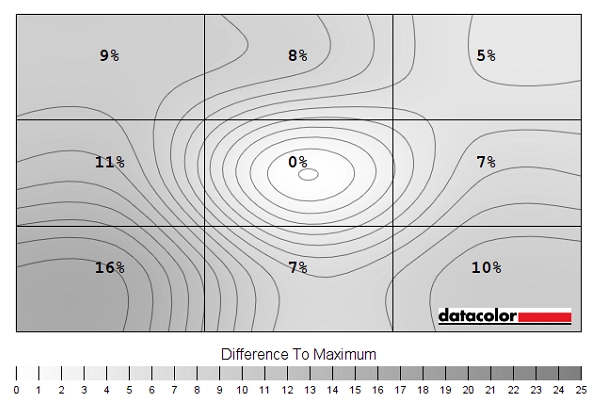
Luminance uniformity map
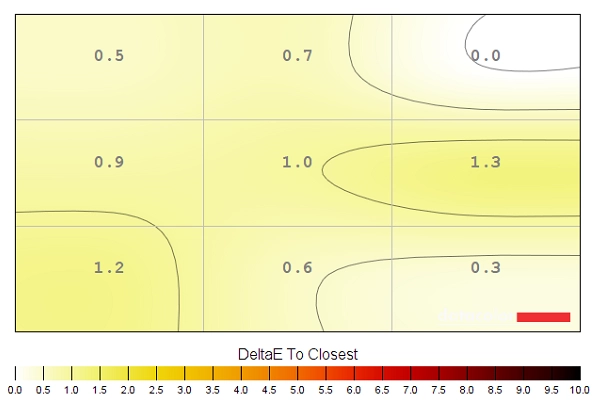
Colour temperature uniformity map
Contrast in games and movies
Lagom contrast tests
Colour reproduction
Colour gamut
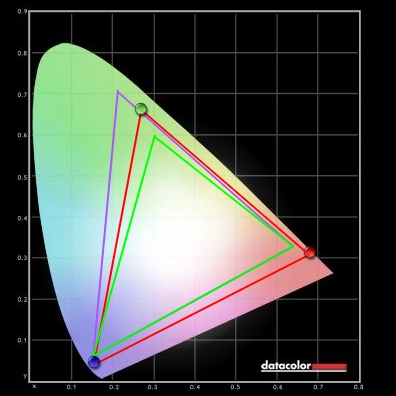
Colour gamut 'Test Settings'
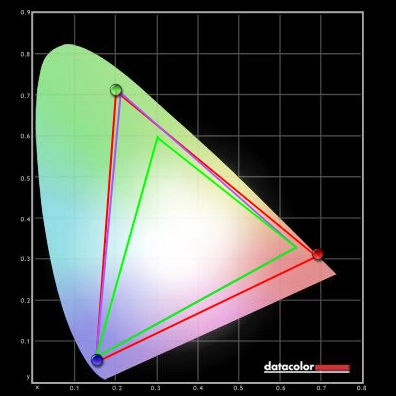
Colour gamut PG27UQ (for comparison)
The monitor also offers an sRGB emulation mode (‘SDR Colors sRGB’ in the ‘Color’ section of the OSD). This cuts down the colour gamut significantly so that it closely matches the sRGB reference space. This enhances colour accuracy for sRGB content, so is useful for colour-critical work within that space or for users who prefer accuracy over vibrancy. We recorded 98% sRGB coverage using this mode, with no extension beyond – so an effective sRGB emulation setting. If you’re calibrating the monitor with your own colorimeter or similar device and have a colour-managed workflow, stick with the native gamut of the monitor. This provides full sRGB coverage with over-extension being accounted for during the profiling process.

Colour gamut 'sRGB'
Colour in games and movies
Viewing angles
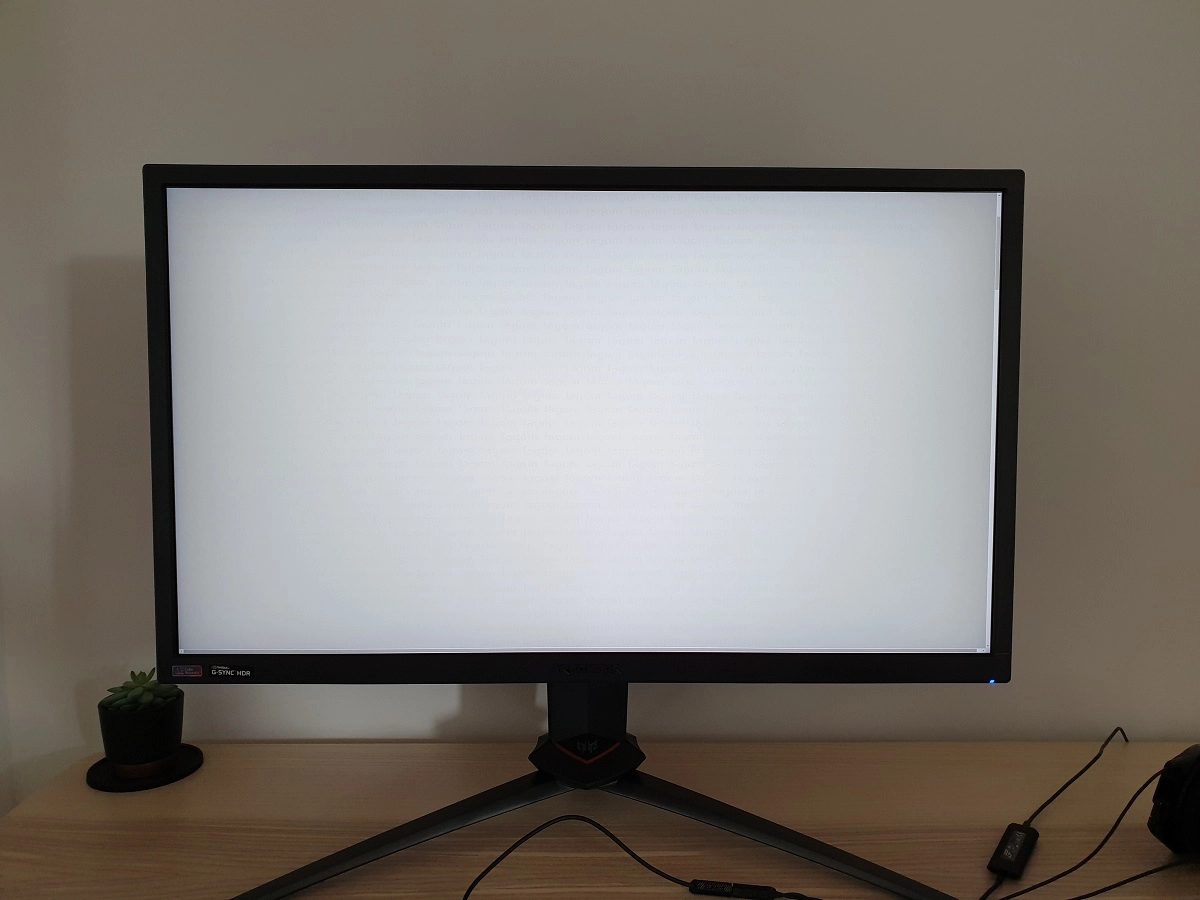
The following video shows the Lagom text test, a mixed desktop background and dark desktop background from various viewing angles. For the mixed image you can see slight shifts in colour and contrast, particularly at sharper viewing angles, but an image that’s relatively well maintained overall compared to non IPS panels. The dark desktop background highlights ‘AHVA glow’, showing how it manifests itself off-angle and blooms out noticeably from sharper viewing angles.
Interlace pattern artifacts
Responsiveness
Input lag
Perceived blur (pursuit photography)
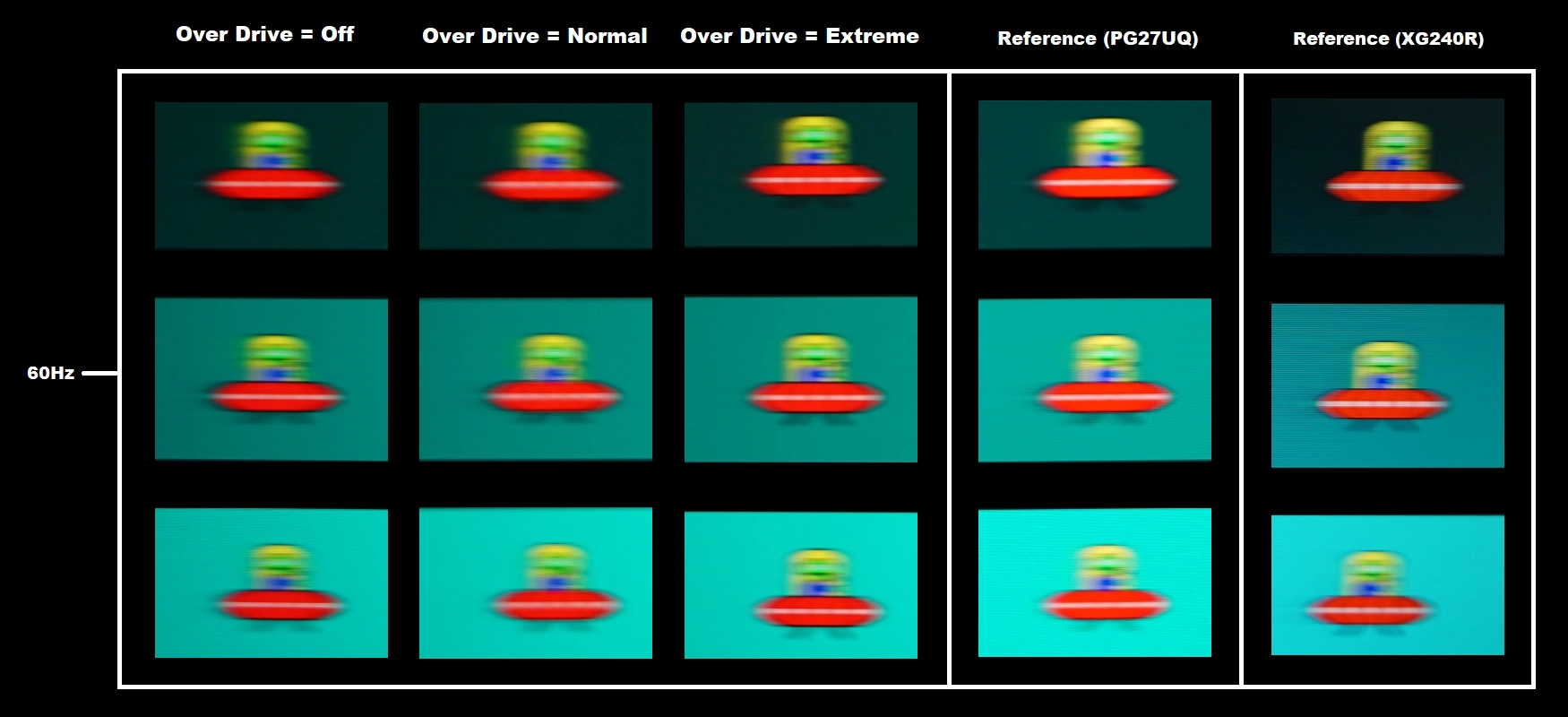
At 60Hz, shown above, the UFOs appear relatively soft and unfocused with a lack of distinct detail. This indicates a moderate level of perceived blur attributed to eye (camera) movement. There are varying degrees of trailing behind the object due to some weaknesses in pixel responsiveness. These are clearest with ‘Over Drive’ set to ‘Off’, where you can see a moderate powdery trailing behind the object for all rows. The ‘Normal’ setting cuts this down significantly, so only a light powdery trail remains for the dark (top row) and medium (middle row) backgrounds. The light background appears very clean. Overall, this is similar to the ASUS PG27UQ reference. The ‘Extreme’ setting cuts out the conventional trailing completely and actually appears cleaner overall than the XG240R reference, particularly when considering the medium background. There is a bit of overshoot (inverse ghosting) behind the object for the bright background, although it is faint. In practice there are some more noticeable examples of overshoot for other transitions when using this setting. We’d therefore consider both ‘Normal’ and ‘Extreme’ to be good settings for 60Hz – with the appropriate setting depending on your preference for a little conventional trailing vs. a bit of overshoot. The image below shows how things look with the refresh rate raised to 98Hz.
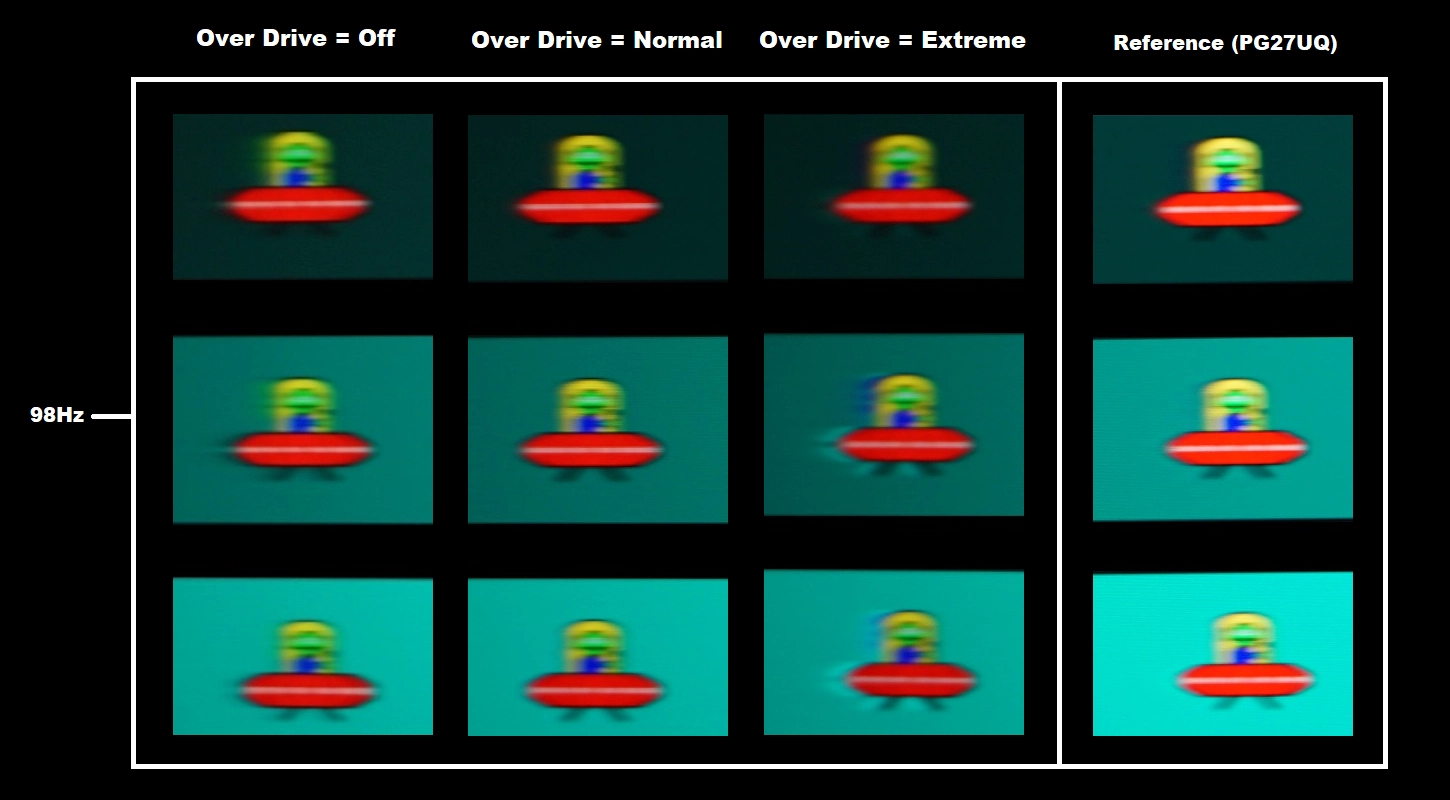
At 98Hz, above, the UFOs appear somewhat narrower and slightly more focused, indicating a significant decrease in perceived blur due to eye movement. There is again varying amounts of trailing behind the UFOs, with the nature of this trailing appearing quite different to at 60Hz. The ‘Off’ setting reveals a bold powdery trailing, revealing pixel responses that are simply too slow for effective performance at this refresh rate. They therefore add significantly to the overall perceived blur. The ‘Normal’ setting cuts this out very effectively indeed. There is the smallest hint of ‘powdery’ trailing behind the UFO body for the dark background and a small amount of overshoot (dark ‘shadowy’ trailing) elsewhere. But a very clean performance – slightly cleaner than the PG27UQ reference, even, particularly for the dark background. The ‘Extreme’ setting introduces colourful and very eye-catching overshoot, so is not attractive. ‘Normal’ is clearly optimal here and very well-tuned overall. The image below shows things increased to 120Hz.
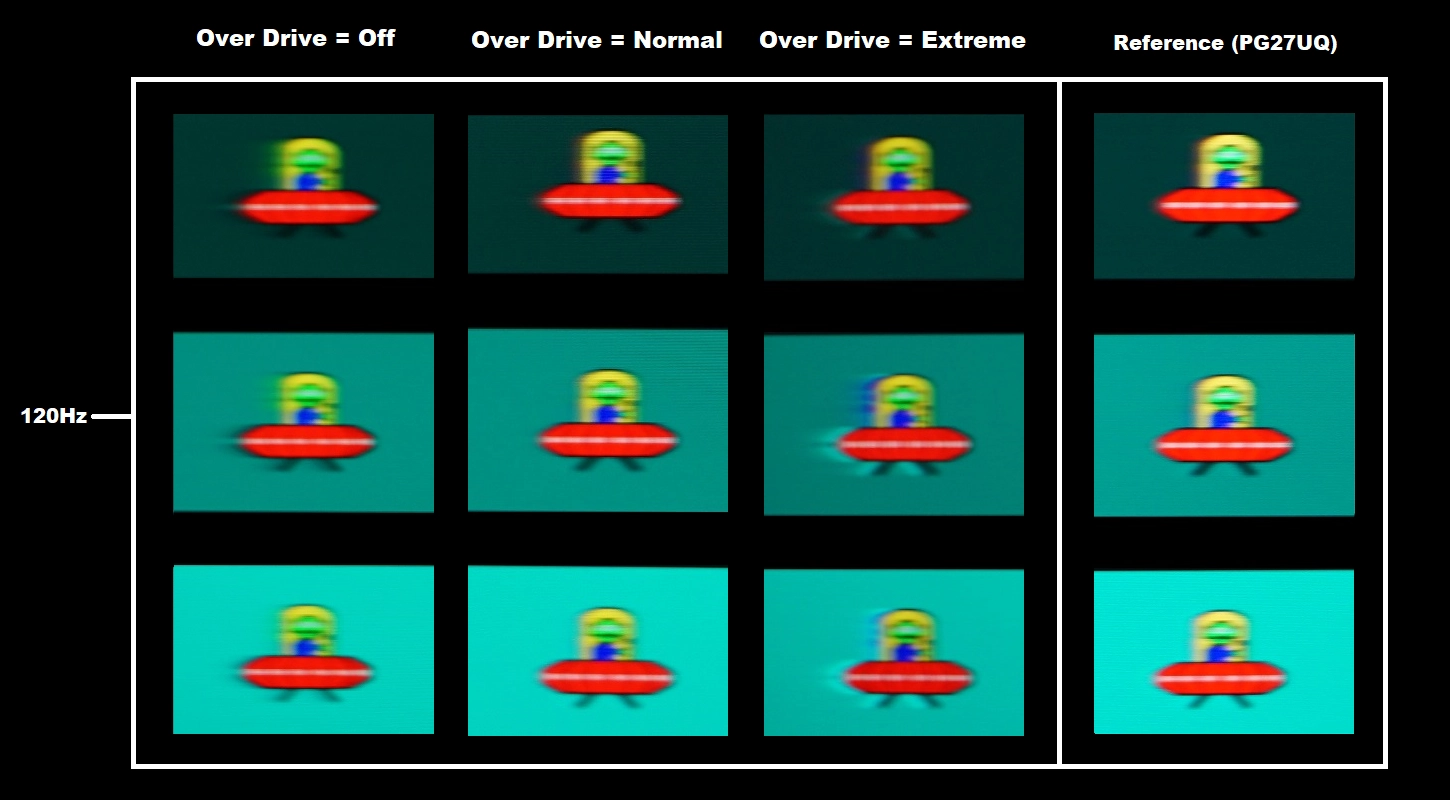
At 120Hz, above, the UFOs appear slightly narrower again with some sharper detailing, indicating a further reduction in perceived blur due to eye movement. The trailing is quite similar to at 98Hz, really. The ‘Normal’ setting is again optimal and similar to the PG27UQ if not slightly cleaner. There is again just a hint of light powdery trailing for the dark background and some faint overshoot elsewhere, but nothing eye-catching. The ‘Extreme’ setting lives up to its name and gives extreme overshoot – not pleasant to look at, ‘Normal’ is clearly much better optimised. The final image, below shows the refresh rate increased to 144Hz. Using the ‘Over Clock’ feature in the ‘Gaming’ section of the OSD to include this as a listed refresh rate.
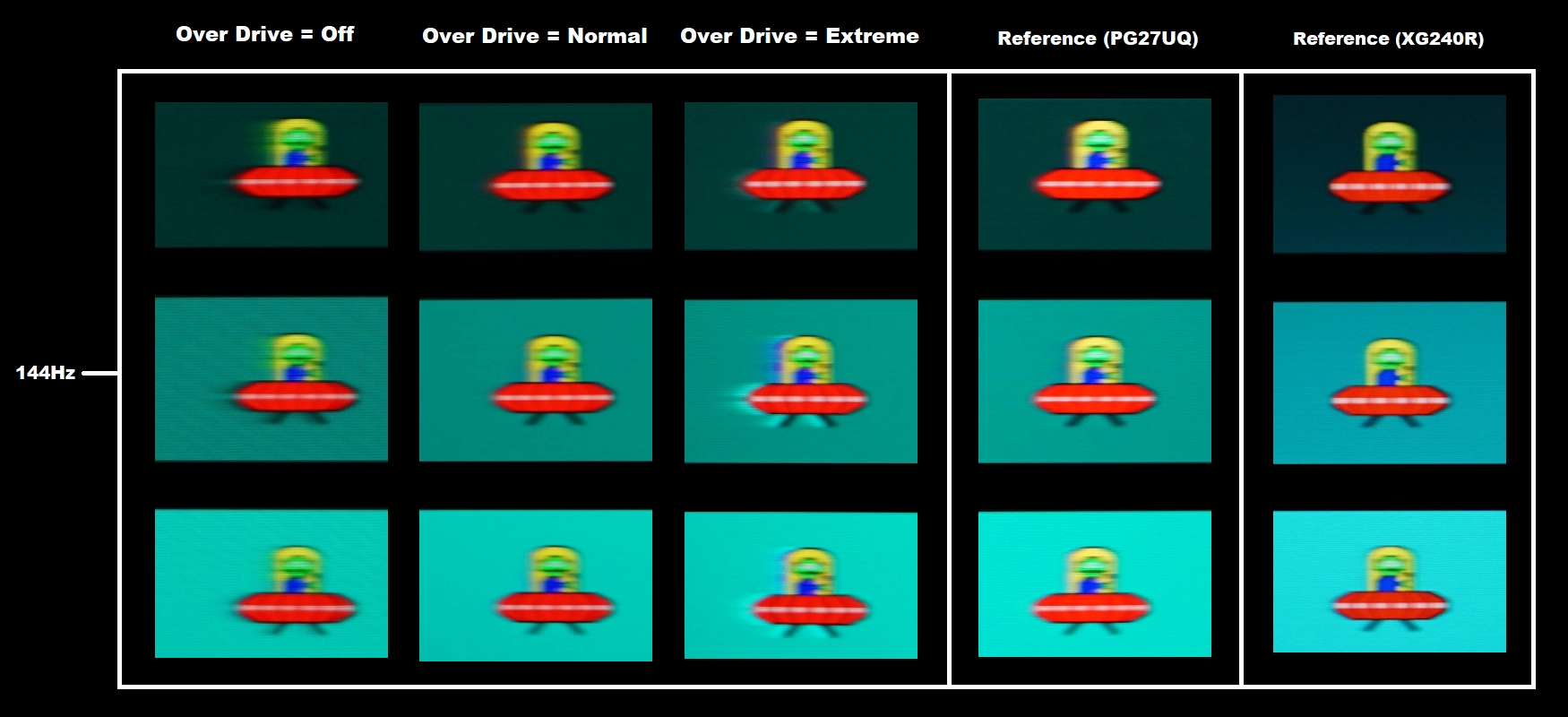
At 144Hz, above, the UFOs have a slight edge in detailing – with slightly more distinct segmentation. And they’re marginally narrower. This reflects a further decrease in perceived blur due to eye movement. The trailing behind the UFOs is very similar to at 120Hz. The ‘Normal’ setting is clearly optimal and nicely tuned here, with a very small amount of powdery trailing for the dark background and a little overshoot elsewhere. But this is not extreme and sticks quite tightly to the object rather than extending further back. It appears quite blended overall – certainly when compared to the obnoxious overshoot using the ‘Extreme’ setting’. The ‘Normal’ setting appears similar to the PG27UQ reference overall, with overshoot appearing slightly weaker (which is good). The segmentation is less clear on the PG27UQ shot, but that’s due to the camera picking it up slightly differently rather than an actual observable difference there. The XG240R reference is beautifully clean without any clear conventional trailing or overshoot – an absolute benchmark for excellent 144Hz sample and hold pixel response performance. Which the XB273K isn’t too far away from really.
Responsiveness in games and movies

G-SYNC – the technology and activating it
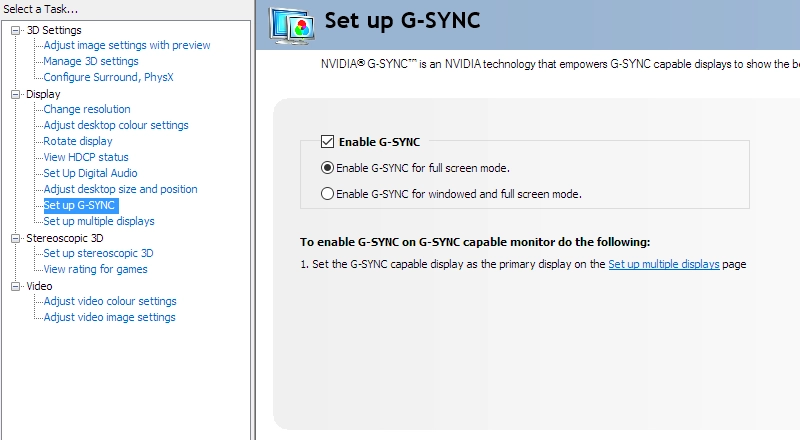
Enable G-SYNC
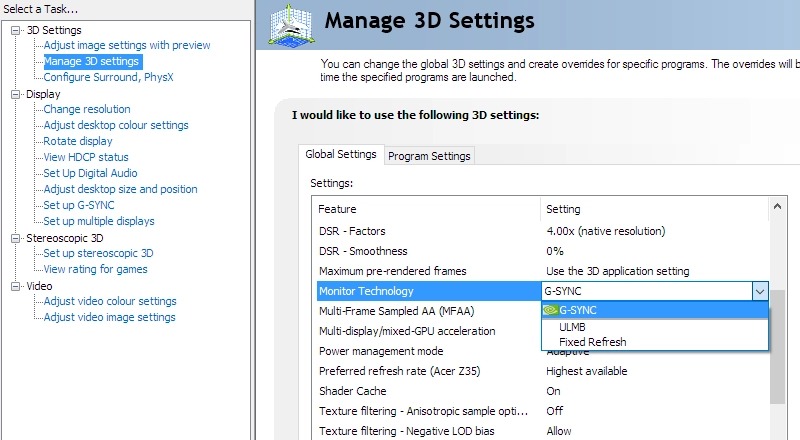
Set Monitor Technology to G-SYNC

Set VSync according to preferences
G-SYNC – the experience
SDR Variable Backlight
HDR (High Dynamic Range)
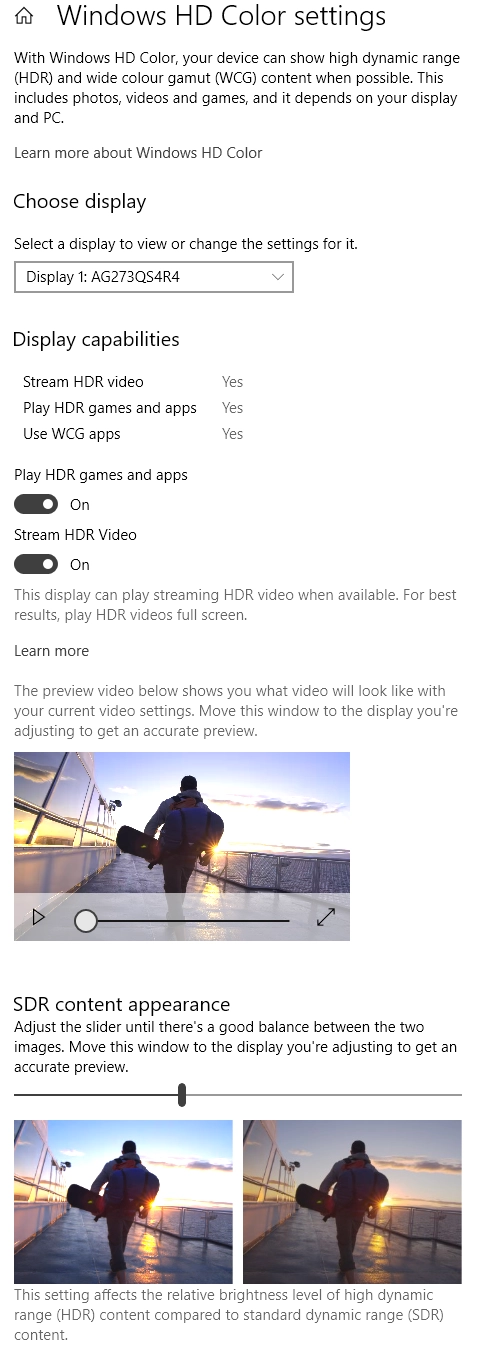

Colour gamut 'Test Settings'
The ‘4K’ UHD experience
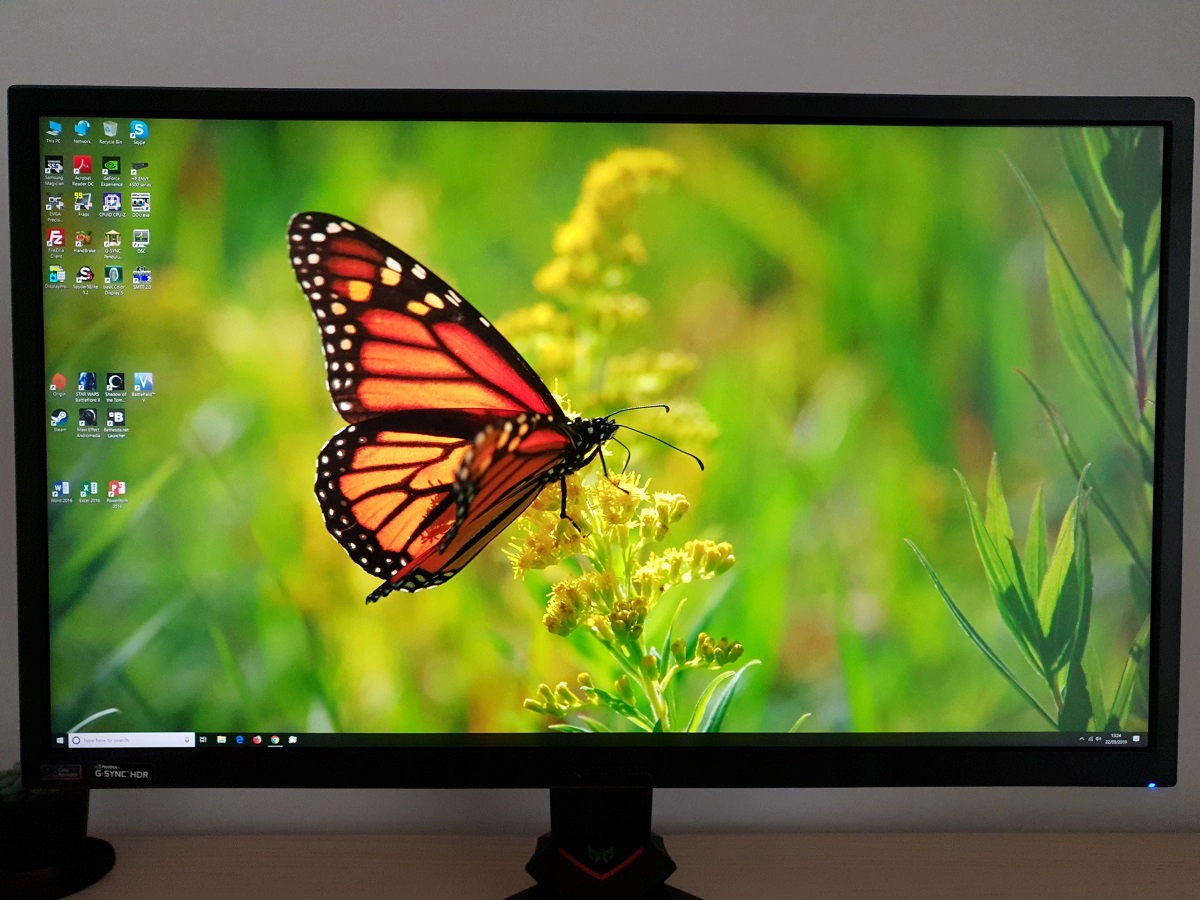
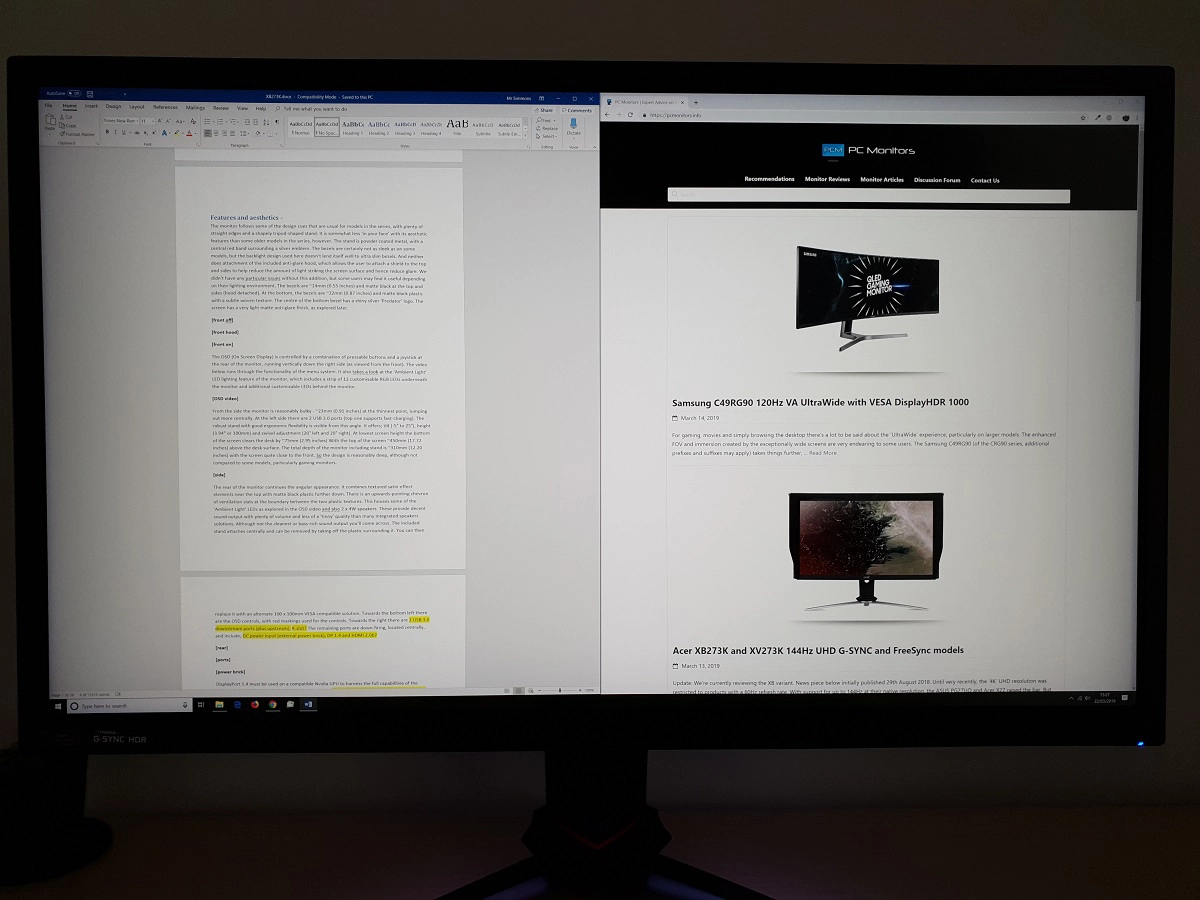
The strong pixel density of 163.18 PPI also gives excellent detail and clarity to suitably high resolution images, movies and games. For gaming, in particular, there are some quite spectacular elements that really deliver something beyond what models with significantly lower pixel density deliver, including 27” 2560 x 1440 models. There is a certain detail and clarity that’s simply lacking with these significantly lower pixel densities. Things work best where games feature high resolution textures, complex special effects and suchlike. But even as far as lower graphics settings are concerned, there is a certain clarity and definition to the edges of objects that is distinctly different to what you’d otherwise see. It makes enemies easier to spot in the distance and, when combined with the high refresh rate, gives a surprising competitive advantage. This overall definition is just generally pleasing on the eyes, too. It’s true that you can gain a similar look to things from ~32” UHD screens, and the physically larger screen size can appeal to some – but it’s absolute nonsense to consider the resolution to be ‘wasted’ on a screen of this size. Combining this with the high refresh rate was also quite something, as it helped preserve this detail better during movement (due to significantly lower levels of perceived blur). The images below show a range of games in action on the monitor – they in no way reflect what the monitor look like first hand, they’re simply there to fire up the imagination.
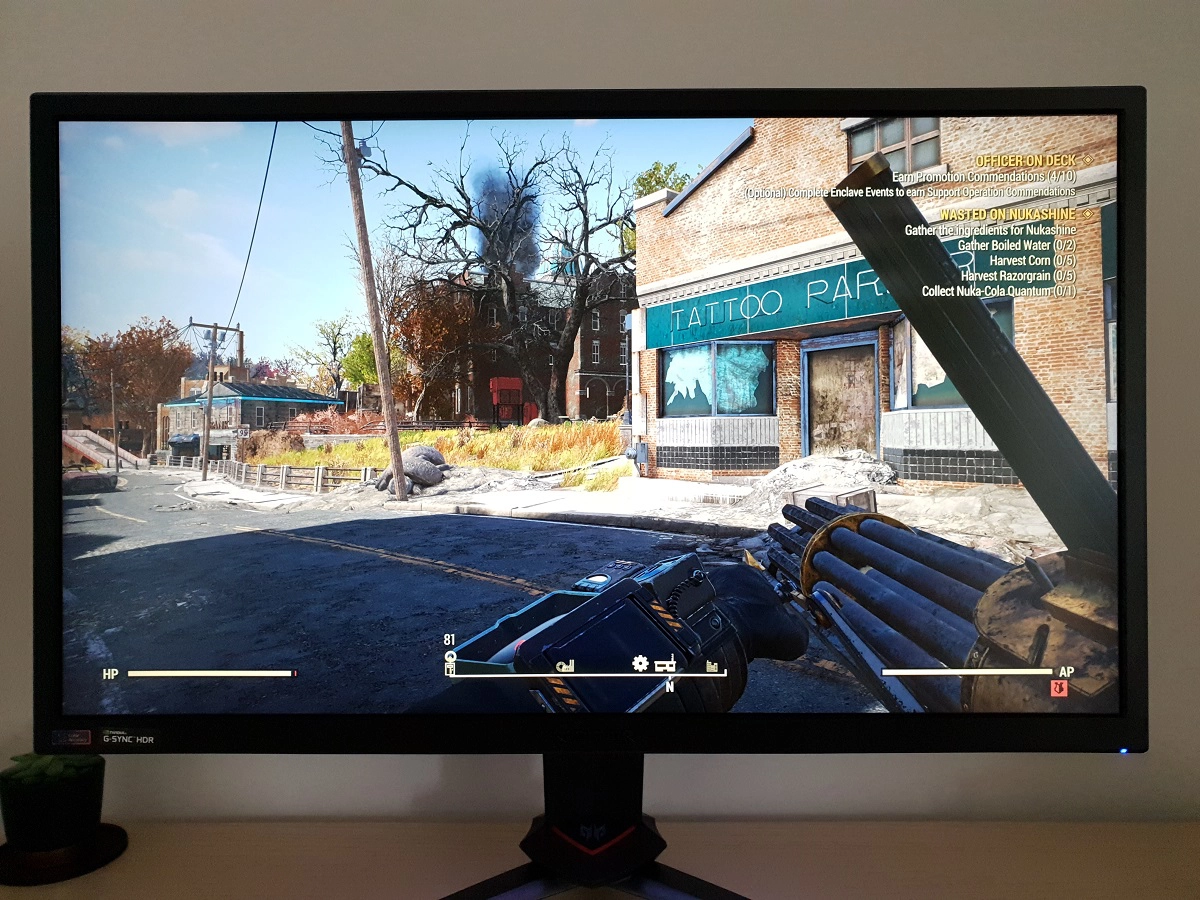
Interpolation and upscaling

Video review
Timestamps:
Features & Aesthetics
Contrast
Colour reproduction
HDR (High Dynamic Range)
Responsiveness
Conclusion
The bottom line; a well-tuned monitor with vibrant but varied colour output and strong responsiveness, with some (but certainly not all) boxes ticked for a decent HDR performance.

Positives Negatives Vibrant and varied colour output with generous extension beyond sRGB, an effective sRGB emulation setting and strong colour consistency from the AHVA panel
DCI-P3 coverage not as high as some models Static contrast is respectable, the very light matte screen surface helped preserve vibrancy and clarity, whilst the VESA DisplayHDR 400 support was good as far as solutions of this ‘level’ go ‘AHVA glow’ affected detail and atmosphere in dark scenes. Very limited local dimming capability and relatively limited peak luminance mean this is far from a ‘full fat’ HDR experience Well-tuned pixel overdrive and fairly low input lag helped deliver a solid performance at up to 144Hz. G-SYNC did its thing to help with those almost inevitable dips in frame rate
144Hz requires chroma subsampling which has an obvious effect on text clarity for desktop usage and affects HDR frame rate – in-game there was no observable negative image quality impact, however A solidly built product with an excellent pixel density, giving good detail and clarity for suitably high resolution content and plenty of ‘desktop real estate’
Quite an expensive monitor and an active cooling solution which could rub some users up the wrong way (we didn’t find this problematic ourselves)
As an Amazon Associate I earn from qualifying purchases made using the below link. Where possible, you’ll be redirected to your nearest store. Further information on supporting our work.


